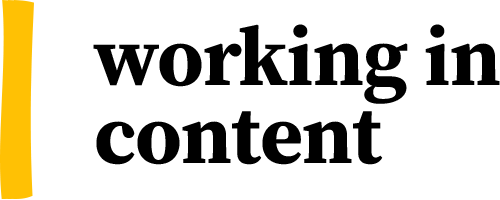

Content Director Job Description: Examples from Headspace and Lego
An in-depth look at the role of a Content Director, with examples from Headspace and Lego. Includes salary expectations, responsibilities, qualifications, benefits, and diversity considerations.

On this page:
Introduction, typical responsibilities, qualifications, skills and attributes, diversity and inclusion, next steps: writing your job description.
- TEMPLATE Download our Content Director Job Description template
Job descriptions are not as easy to put together as people might think. And for content roles, you're writing to people who are content creators themselves, so you need to appeal to them, and show some personality, while still covering all the vital information and business needs.
In this article we deconstruct adverts for Content Director roles from two well-known companies, and we've created a free template for you to build on when creating your own.
To give you an understanding of the Content Director role, we'll define it first.
Then we'll see what job descriptions from Headspace and Lego look for in candidates.
Things like:
- What they offer in terms of salaries
- Key responsibilities
- Qualifications and skills
- Benefits, workplace experience and culture
- Diversity and inclusion statements
We've also included some comparative analysis of the two job descriptions.
Let's dive in.
What is a content director?
A content director is responsible for executing and overseeing content strategy. They need creative vision, collaboration skills, the ability to understand and work with stakeholders, and the ability to see the big picture for this role.
In some organisations this role is effectively the same as a creative director. Candidates are accountable to deliver content that is engaging, meet KPIs, metrics, and drive revenue through content.
What to include: Examples from Headspace and Lego
Now let's break down two examples of job descriptions from Headspace and Lego We'll cover all the key areas such as salary, responsibilities, key skills and qualifications, as well as some deeper comparative analysis further down the page.
Showing the salary that you're willing to pay in a job description is crucial for many reasons. Transparency promotes trust, as well as being important for diversity and inclusion. Show the Pay say on their website:
"Diversity and bias are key issues in recruiting. But when you don't say what you are willing to pay in a job advert, you are being exclusive and continuing to perpetuate and widen the gender, ethnicity and ability pay gaps."
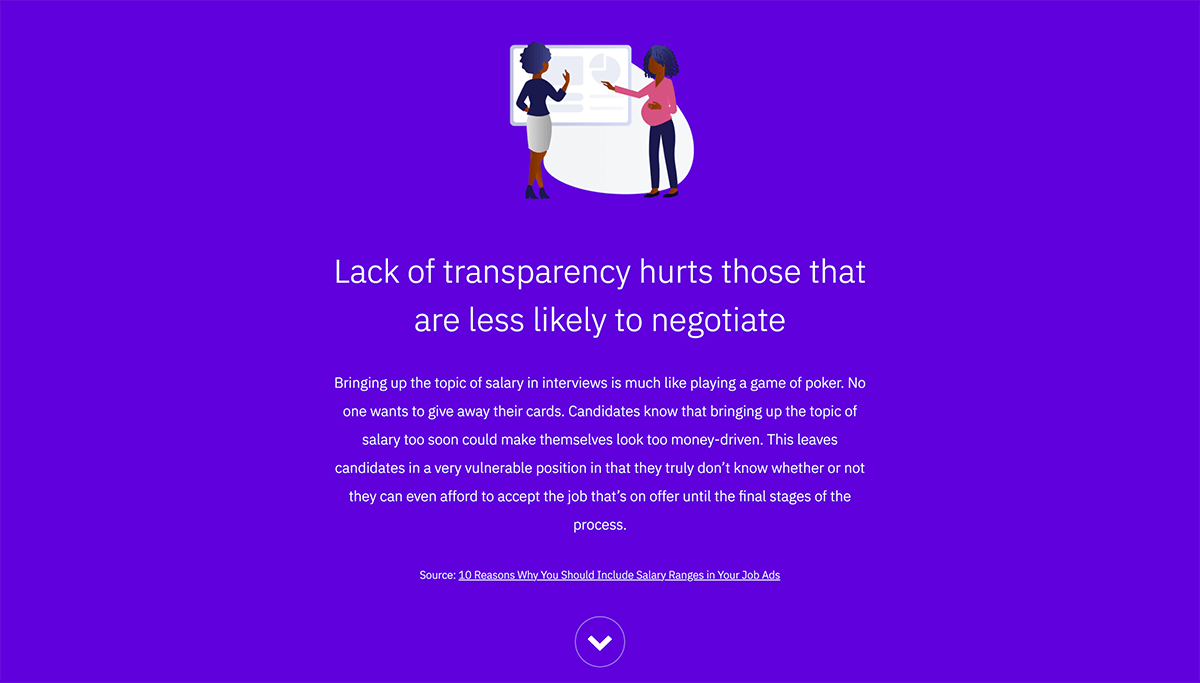
Side note: All content director jobs that share pay details on our site are highlighted by a green dollar symbol to bring attention to this.
Neither Headspace or Lego specify their salary in the job description. Although they both do have some other really good key points. (Their diversity and inclusion statements themselves are great examples).
The Headspace role is in London (Remote), and the Lego role is in Billund, South Denmark.
While the data is sketchy for these roles, we have used LinkedIn, PayScale and Glassdoor to find out averages for a Content Director role in these locations where we can.
Salaries are great in Denmark (we found this report on salaries in Aarhus , however there is only data for a copywriter). And we have had to use a Creative Director role for Denmark, but as we'll discuss later in this article, a Content Director can sometimes function as (or similar to) a Creative Director.
Here is a quick breakdown table of typical responsibilities and criteria for the role of Content Director so you can make sure you are hitting all the key points in your content job description.
We've grouped them into key areas, and you can see which have been included from Headspace and Lego. The Headspace role is for a Content Director (which for them is more akin to a Creative Director). And the Lego advert is for an Editorial and Content Director.
Both are Senior / Leadership roles which is reflected in the responsibilities and qualities required. The Headspace role has a specific focus on international, too.
Now onto skills and qualifications. We've added details such as how many years' experience where the data is available. You'll see that as these are Senior roles, the years' experience required is high, and the sorts of qualities they look for are from somebody who is well-versed and professionally developed in content. They ask for:
Here we will look at the benefits offered by each company. When creating your job description, think about deeper, meaningful benefits like company culture and support networks.
Neither company has included benefits in their job descriptions. This may be because they are Senior roles and so therefore more thought and more of the word count has had to go into the overall summary and details.
That said, we still think it's important to include benefits where you can. This is so you can give candidates a full picture of the company they are applying to, and the culture.

We have found benefits for both Headspace and Lego online where we could. We've used the company websites (although not much information is on there) as well as Glassdoor and this article on Headspace's benefits to give you a more comprehensive view. This isn't an exhaustive list but hopefully should give you a fairly rounded picture.
Diversity and inclusion as we've talked about already is crucial to be aware of when writing job descriptions, with many organisations now making a conscious effort to ensure they are hiring fairly and diversely.
Despite this, many still fail to include a diversity and inclusion statement in their job descriptions. Not only this, but often we see job descriptions that are laid out in a way that isn't very user-friendly, with lack of bullet points and walls of text.
Ideally, you should also make reference to reasonable adjustments and accommodations being available to candidates throughout the selection process, as this is a required for diversity and inclusion.
That said, it shouldn't just be a tick-box exercise. Be sincere about your commitment to diversity and inclusion by using positive language and creating your own statement, rather than just copy and pasting one.
Headspace have an excellent diversity and inclusion statement in their job description. And they have weaved in their approach through the language and tone of voice they use throughout. It's clear a human has written this and it's not just copied and pasted, and it really shows off their company culture.
"How we feel about Diversity & Inclusion:
Headspace is committed to bringing together humans from different backgrounds and perspectives, providing employees with a safe and welcoming work environment free of discrimination and harassment. We strive to create a diverse & inclusive environment where everyone can thrive, feel a sense of belonging, and do impactful work together. As an equal opportunity employer, we prohibit any unlawful discrimination against a job applicant on the basis of their race, color, religion, gender, gender identity, gender expression, sexual orientation, national origin, family or parental status, disability*, age, veteran status, or any other status protected by the laws or regulations in the locations where we operate. We respect the laws enforced by the EEOC and are dedicated to going above and beyond in fostering diversity across our workplace.
*Applicants with disabilities may be entitled to reasonable accommodation under the terms of the Americans with Disabilities Act and certain state or local laws. A reasonable accommodation is a change in the way things are normally done which will ensure an equal employment opportunity without imposing undue hardship on Headspace. Please inform our Talent team if you need any assistance completing any forms or to otherwise participate in the application process."
We can see that Headspace talk about not just diversity and inclusion obligations, but that they strive to go "above and beyond" and create a positive and inclusive workplace culture. They then go on to actually explain terms such as what 'reasonable accommodation' means in terms of disabilities in the hiring process.
The lego statement is also another great example, as it's not just generic but tailored to fit the context of the role. They start off with"join the global Lego family" and their values, and how they want to create a safe, belonging space for employees.
"Join the global LEGO® family
Children are our role models. Their curiosity, creativity and imagination inspire everything we do. We strive to create a diverse, dynamic and inclusive culture of play at the LEGO Group, where everyone feels safe, valued and they belong.
The LEGO Group is proud to be an equal opportunity and an affirmative action employer. We are committed to equal employment opportunity regardless of race, colour, ancestry, religion, sex, national origin, sexual orientation, age, citizenship, marital status, disability, gender identity or Veteran status.
We support our employees in being there for the moments that matter in life and celebrate families of all kinds, the loved ones that make us who we are. Being part of the LEGO Group also means taking part in our annual Play Day, playing a part in building a sustainable future and continuing our mission to "inspire and develop the builders of tomorrow."
It's good to see a focus on family which carries over into their employee values and company culture, and it's again in the context of the job description, and written with the candidate reading in mind.
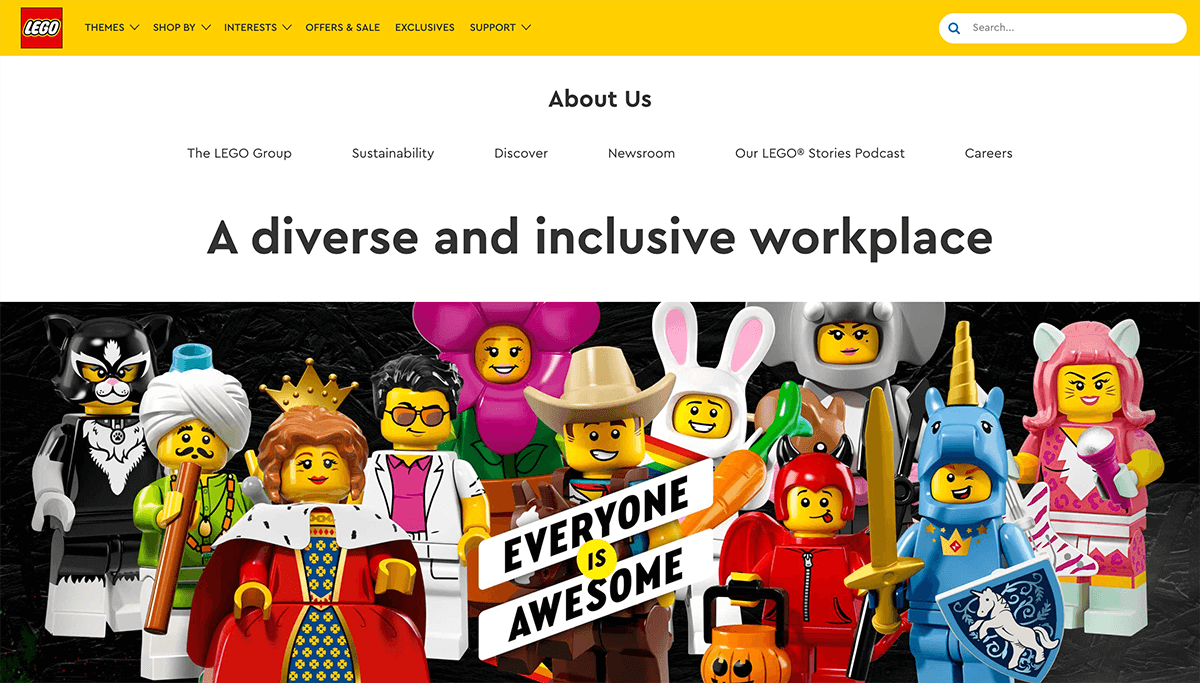
Highlights: comparing and analysis to inspire your job description
Finally, in this section we've pulled out some key quotes, done some analysis and compared the two job descriptions even further. This should help you gain a deeper understanding of what the role of Content Director for these two organisations entails, and what companies ask for. We've also included links to docs with the full adverts if this is helpful.

For their International Content Director role, Headspace say that
"Externally, this position is equivalent to a Creative Director" so it is expected that the salary would be quite high (although it doesn't say) and responsibilities to match this.
They kick off the job description with:
"As we expand to become a truly global brand, it's important that we maintain the level of excellence in content for which we are famous. The role of the Content Director will lead the content creation process in multiple countries beyond the English-speaking world."
From the outset, it is clear that this position is international, and aside from needing somebody who is bilingual (as stated in the table), candidates also need:
"An in-depth understanding of multiple International cultures especially Germany, France, Spain and Australia is crucial. This role is based out of England."
The job looks like it is heavily focused on collaboration and partnering with different teams such as the data team, and the international marketing team, to ensure content is marketed correctly to local cultures.
It also includes things like securing native speaking and creative talent for the app.
"Working with artists, musicians, and voice over talent you will curate, program, and commission content for our international products, including meditation teachers, sleepcasts and more."
An interesting part of the job description is when they say they need somebody who can:
"identify the "active-ingredient" in our existing content, and work out how to frame that in new geos - think, trans-creation, rather than translation."
So they are wanting to keep the brand consistent across channels and locations.
In terms of content strategy, they are looking for:
"an expert in creating world-class digital content. This person will be highly collaborative, detail-oriented and a strong communicator, working cross-functionally with internal stakeholders to maximize efforts and with our Head of Content on strategic vision, budget tracking and resource allocation."
They need somebody who can
"work with the product to make sure that the content is properly accessible and organized within our app to maximize engagement."
When it comes to personality traits they are looking for leadership qualities, and they say:
"To be successful, this Content Director should be comfortable in ambiguity, enjoy problem solving, have a POV and a clear creative vision."
Headspace also have a really nice way of phrasing the headings of their sections - for example:
For the responsibilities section they say "How your skills and passion will come to life at Headspace"
For the experience and skills part, they say "What you've accomplished"
Here is a link to the full job description for Headspace

This is an English speaking role in Denmark for an Editorial and Content Director. While similar to the Headspace role, and a global brand, there isn't as much focus on international. And while the Headspace role is akin to a Creative Director, instead, the focus is more geared towards content strategy. This role is, in some ways, similar to that of a content strategist.
The job description is well-laid out and easy to read. After introducing the advert, they kick off the core responsibilities section with:
"As the Director of Editorial and Content you will be responsible for leading the editorial and content strategy and teams across the kids and family digital ecosystem."
They also go on to say:
"You are uniquely placed within the Product and Marketing group to provide a center of excellence and a deep understanding of innovative and relevant content"
We've picked out some key parts that are to do with overall responsibilities, and grouped them together. The chosen candidate will:
"Own the Editorial and Content strategy for Kids, Cross Audience and Family Engagement (KECAFE) initiatives across the LEGO® ecosystem, within the Digital Consumer Engagement Division."
"Be the point of contact for editorial storytelling across Kids and Family engagement."
"Lead innovation and best-in-class editorial and content strategy and implementation throughout the LEGO® digital ecosystem touchpoints."
Again, for this role, like Headspace's Content Director role, there is a focus on collaboration, communication across departments and stakeholder management. As well as leadership, influence and mentoring.
In terms of personality, they say:
"To thrive in this position, you love working in the area, where creative ideation meets execution excellence. Being an awesome leader and teammate you easily communicate to partners, involving your colleagues across functions."
And they need somebody who can:
"Influence alignment and collaboration with other editorial & content-led teams across the LEGO Group e.g. Social Media."
"With a focus on quality, innovation and efficiency, ensure the best solutions for stakeholders."
Ultimately, Lego are looking for an Editorial and Content Director who can:
"Drive reach, reputation and revenue through ongoing engagement within and kids' and parents' digital touchpoints in the ecosystem, aiming to delight recruit and retain audiences."
Here is a link to the full job description for Lego
Hopefully this article has given you an idea of some of the similarities and differences between the two Content Director job descriptions, and some inspiration for writing one of your own. If you need help with this, download our free template:
Use this Content Director Job Description Template as a base, or to inspire your own. It's comprehensive and includes example excerpts discussed in this article.
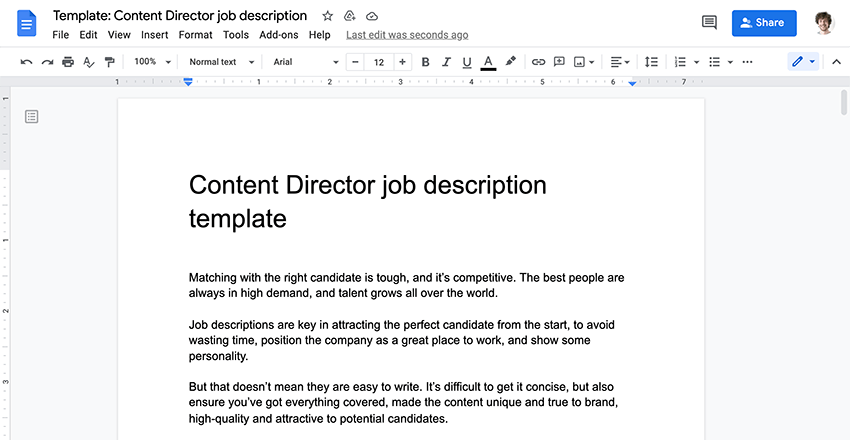
Each week we share peer interviews, fresh jobs, links and resources to help your career grow.
12 new jobs added in the last week.
- Content Design (81)
- Content Strategy (135)
- UX Writing (59)
- Content Marketing (0)
- Content Management (1)
- Technical Writing (0)
- Remote (52)
- US East Coast (69)
- US West Coast (26)
- Silicon Valley (14)
- California (19)
- Virginia (6)
- Europe (76)
- San Francisco (15)
- New York City (21)
- Los Angeles (4)
- Washington, DC (12)
- Philadelphia (30)
- London (27)
- On-demand Video Interviews
- Live Interviews and Scheduling
- Applicant Tracking Software
- Interview Questions & Job Descriptions
- Careers Page Builder
- Assessments, evaluation, testing
- AI Assistant & Virtual Recruiter
- Plagiarism Checker
- Integrations
- Mobile Applications
- Collaboration Tools
- Tutorials & Help Center
- Quick Product Tour (2 min video)
- Free Job Description Templates
- ROI Calculator
- Developer Resources
- API Reference
- System Status
- Interview Prep
- Search for jobs
- Resume Builder
- Resume Templates
- Resume Examples
Director Job Description Template
A director plays a crucial role in any organization, overseeing all aspects of operations, management, and strategy. To attract the right candidates for this pivotal role, it's essential to have a well-crafted job description. A director job description template outlines the key responsibilities, requirements, and qualifications for the position, providing a clear framework for applicants to understand what's expected of them. With a comprehensive job description, you can ensure that the person you hire has the skills, experience, and vision needed to successfully lead your organization.
Job Overview
The Director is responsible for overseeing all departments and operations within an organization. They work closely with other senior management to develop and implement strategic plans to achieve organizational goals.
Responsibilities
- Develop and implement strategic plans to achieve organizational goals
- Oversee all departments and operations within the organization
- Work closely with other senior management to ensure efficient and effective business processes
- Lead and manage a team of managers and employees to achieve organizational objectives
- Develop and maintain relationships with key stakeholders, including customers, suppliers, and partners
- Analyze market trends and competitive activity to ensure the organization remains competitive
- Ensure compliance with relevant laws and regulations
- Develop and manage budgets to ensure financial sustainability
- Identify and pursue opportunities for growth and expansion
Requirements
- Proven experience as a Director or in a senior leadership role
- Strong strategic planning and execution skills
- Excellent communication and interpersonal abilities
- Ability to lead and manage a team effectively
- Strong financial acumen and budget management skills
- Ability to analyze market trends and competitive activity
- Excellent problem-solving skills
- Bachelor's degree in Business Administration or a related field; Master's degree preferred
Introduction
When you're looking to fill a Director position within your organization, it's vital to write an effective job posting that stands out from the competition. A well-crafted job post will attract qualified candidates who are ready to take on the challenges of this senior leadership role. Here are some essential ingredients to include in your Director job posting.
The job title should be clear and concise. In this case, you're looking for a Director, but if the position has a specific focus such as Director of Sales or Director of Marketing, make sure to include that in the job title. A strong job title will give applicants a good idea of what the position entails.
Your job posting should have a brief summary of the position. The job summary should highlight the main responsibilities of the Director, a short description of the organization, and the ideal qualifications of the applicant. Keep it concise but informative!
The job responsibilities section should outline the key duties and responsibilities of the Director. This will give the applicants a clear understanding of what the role entails. It is useful to separate the essential duties from the non-essential ones.
- Develop and implement strategic plans and goals that align with the organization's mission.
- Oversee the day-to-day operations of the department/team.
- Lead and manage staff performance and development.
- Ensure the department is functioning efficiently and effectively in achieving its goals.
- Evaluate and improve the quality of services and programs provided by the department.
Qualifications
The qualifications section should highlight the skills, experience, and education required for the position. Be specific about the requirements to prevent unqualified applicants from applying.
- Bachelor's or Master's degree in a relevant field.
- Minimum of 10 years of experience in a leadership role, preferably in the same industry as your organization.
- Demonstrated track record of success in managing teams and achieving goals or targets.
- Excellent communication, interpersonal, and leadership skills.
- Strong analytical and problem-solving skills.
- Salary and benefits
Include the salary range and benefits for the role. This should be competitive based on market rates and commensurate with the responsibilities of the position. Benefits may include health insurance, retirement, and paid time off.
Writing a job posting for a Director position requires careful consideration of the position's requirements and the skills needed to succeed. Use the above elements as a guide to craft a job posting that will attract the right candidates and help your organization achieve its goals.
What is a Director job posting?
A Director job posting is a written advertisement that provides information about an open Director position that an organization wants to fill.
What are the most important elements of a Director job posting?
- Job title and department
- Overview of the job description and responsibilities
- Qualifications and required skills
- Education and experience requirements
- Location and work schedule
- Application instructions and deadline
What should be included in the job description section?
The job description section should provide a detailed summary of what the role entails, including key duties and responsibilities. It's important to use clear, concise language and include any technical skills or knowledge that is required. It's also helpful to include any desirable traits or culture fit that your organization might be seeking in a candidate.
How should I word the qualifications section?
The qualifications or requirements section should be straightforward and easy to understand. It should include the minimum education and experience requirements, as well as any necessary certifications or licenses. Additionally, it's helpful to include any specific software or tools that are required for the job.
What should I include in the company overview section?
The company overview section should give applicants a sense of what it's like to work for your organization. It's helpful to include information on company culture, mission, and values. You can also provide information on any benefits or perks that your organization offers, such as flexible work arrangements or professional development opportunities.
What are some best practices for writing a Director job posting?
- Be concise and clear in your language
- Avoid using jargon or overly technical terms
- Showcase your organization's culture and values
- Highlight the benefits and perks of working for your organization
- Include a clear call-to-action and application instructions
How can I make my job posting stand out?
To make your job posting stand out, consider including any unique benefits or selling points of your organization, such as an innovative work environment or a strong commitment to diversity and inclusion. You can also try to make your posting more visually appealing by including images or graphics. Additionally, try to use language that is exciting and engaging to attract top talent.
Related Job Descriptions
Start saving time and money on recruiting.
Start today for free to discover how we can help you hire the best talents.

This site uses cookies to make it work properly, help us to understand how it’s used and to display content that is more relevant to you. For more information, see our Privacy Policy
Technical Writing Director

United States

Technical Writing Director establishes and plans the overall policies and goals for technical writing function. Develops standard documentation methods to effectively communicate product concepts and technical information. Being a Technical Writing Director coordinates with other teams and departments to determine technical writing needs. Requires a bachelor's degree. Additionally, Technical Writing Director typically reports to a senior manager or top management. The Technical Writing Director typically manages through subordinate managers and professionals in larger groups of moderate complexity. Provides input to strategic decisions that affect the functional area of responsibility. May give input into developing the budget. Capable of resolving escalated issues arising from operations and requiring coordination with other departments. To be a Technical Writing Director typically requires 3+ years of managerial experience.
Employers: Find Surveys For This Job
Employers: Job Description Management Tool
Employees: Get a Salary Increase
- Technical Director
- Estimating Director
- Technical Librarian I
- Technical Writing Manager
- Technical Training Manager
- Technical Writing Supervisor
- Digital Content Writing Director
- Technical Customer Support Manager
- Technical Customer Support Director
- Technical Customer Support Team Leader
- Technical Writing Director Salaries with a Bachelor's Degree
- Technical Writing Director Salaries with a Master's Degree or MBA
- Technical Writing Director Salaries with a JD, MD, PhD or Equivalent
- Media - Print
- Executive and Management
- Aerospace & Defense
- Biotechnology
- Business Services
- Construction
- Edu., Gov't. & Nonprofit
- Energy & Utilities
- Financial Services
- Hospitality & Leisure
- MFG Durable
- MFG Nondurable
- Pharmaceuticals
- Retail & Wholesale
- Software & Networking
- Transportation
- Detroit, MI Technical Writing Director Salaries
- Boston, MA Technical Writing Director Salaries
- Seattle, WA Technical Writing Director Salaries
- San Jose, CA Technical Writing Director Salaries
- New York, NY Technical Writing Director Salaries
- Houston, TX Technical Writing Director Salaries
- Washington, DC Technical Writing Director Salaries
- Atlanta, GA Technical Writing Director Salaries
- Minneapolis, MN Technical Writing Director Salaries
- Salt Lake City, UT Technical Writing Director Salaries
Job Descriptions .
How to write a job description (with examples), how to write a job description.
Job descriptions are the cornerstone of the recruiting process. They help to attract top talent, set expectations for qualified candidates, inform prospects about the role and company, and streamline the search process. Plus, a well-written job description gives companies a chance to make a great first impression. So while writing accurate and compelling job descriptions can be frustrating, finding the time and resources to do so is well worth it.

Importance of Job Descriptions
No matter how many job descriptions you write, they never seem to get any easier, especially if you are writing them for roles you know little about. We’re here to help. For starters, let’s discuss the importance of job descriptions, and then we’ll tackle how to write them.
Job descriptions are helpful for both prospective candidates and employers. Here’s why:
Attract Prospective Candidates
A concise and compelling job description will play a major role in attracting qualified candidates. With resources like LinkedIn, Facebook, Twitter and email, the ability to post and share jobs is instantaneous and has exponential reachability.
Set Expectations
A clear job description will set everyone up for success. Prospects will understand what is expected of them, more-qualified candidates will apply, under-qualified applicants will move on and you will save loads of time sifting through applications and communicating with potential candidates.
Prepare for Interviews
A well-crafted job description can help both applicants and interviewers prep for the big day . Applicants will be able to prepare for likely topics of conversation and interview teams will be equipped to ask questions that will accurately gauge the candidate’s qualifications.
Make a Stellar First Impression
Job descriptions are often the first point of contact candidates will have with your company and can shape their first impression. Just like resumes and CVs, any jargon or grammatical errors will turn a candidate off and leave a lasting negative impression.
Simplify the Search
Searching for jobs is incredibly time-consuming, especially for the 73 percent of candidates who are passive and currently employed. Clear and concise job descriptions help prospects compare salaries, benefits, perks and even company culture to determine what roles are worth applying to.
Establish a Baseline
Once a candidate is hired, the job description will stand as a baseline to measure growth, reference during performance reviews and consider future training opportunities.
Recommended Reading 29 Recruitment Strategies With Real Examples
Great job descriptions are thorough yet concise. They use specific terms and keep a professional tone. It’s OK to be a little quirky, but don’t overdo it. If you don’t take the job description seriously, top candidates will move on to other opportunities.
Important Parts of a Job Description
- Company Bio/Mission
Role Summary
- Role Responsibilities
- Role Requirements (Must-Have Skills)
- Time/Location
- Next Steps (How to Apply)
Here’s an outline of the main sections every job description should include.
Make the job title clear, concise and industry-specific.
43 percent of job seekers look for career opportunities on job boards that use search engine optimization (SEO) techniques. Job seekers are also likely to search based on the terms they know, so don’t stray from the standard industry language of common job titles. Be sure to include specific terms, like the programs required for the role. The title Lead Front End AngularJS Engineer is much more descriptive than Developer and will attract more qualified candidates. If your job can’t be found, it can’t be applied to.
Company Mission
Include a company description or mission, but keep it to about two to four sentences.
72 percent of job seekers noted they would be more likely to apply to a job posting with a company description. At the same time, don’t get too lost in the details. Most companies have a lengthy mission statement with core values and a culture code. For candidates looking at multiple companies and open roles, the missions start to sound the same. If candidates decide to pursue the position, they can read about the company’s full profile on the website.
Consider writing a templated version that can be repurposed whenever you need to write a new job post. It’s also more common to include the company description or mission at the beginning of the post.
Write a brief three to five sentence summary about what the candidate will do in their role, who they’ll work with and any general qualities your team is looking for in the individual.
Job Responsibilities
90 percent of top-performing job descriptions include clear responsibilities and duties, according to Built In research. Responsibilities and duties are essential in order for a candidate to understand the role. They also set expectations for the hired employee and can be used as a baseline for performance reviews down the line.
Give five to 10 bullet points on what the candidate can expect to do in the role. Here are a few tips:
- Write in complete sentences.
- Be thorough. Candidates will be better prepared for the interview and role if they know what is expected of them.
- Don’t be excessive. You don’t need to include every single possible thing a person might encounter during the work day.
Must-Have Skills
Job descriptions include an average of eight distinct qualifications per job post (including must-have and nice-to-have skills), according to Built In research. List five to seven bullet points that are absolutely necessary for a candidate to be successful in the role they are applying to.
- Include quantities when applicable, like years of experience.
- Be sure to clarify what the application requires, like a portfolio, writing sample, video recording, resume, CV, cover letter, etc.
- Other important information includes education, experience, certifications and knowledge of specific platforms.
Nice-to-Have Skills
If there are any other qualities that are nice to have, include those here. Don’t feel like you have to include this section, but it may help candidates know what to include in the application or interview to stand out. This section is lower priority and should have fewer bullet points.
Compensation
61 percent consider compensation information to be the most important part of a job description. However, 99 percent of top-performing job descriptions don’t include compensation information, according to Built In research. Many companies still refuse to provide this information in job descriptions, but it’s time to get over this discomfort to garner a larger applicant pool.
It’s best to be upfront about the time frame you need employees to work. Flexible work hours are more common for full-time employees, time zones may play a role, and certain industries and markets work around different schedules.
Candidates will consider commute time or relocation efforts in their employment decision, so help them determine fit before they embark on the application process. Embedding a Google Map onto your website is really quite simple and can be done with this guide .
Working Conditions
Keep working conditions and workplace expectations clear. People want to know what to expect in their future work environment. Are there any physical requirements for the role? What is the expected dress code?
Call to Action
Make sure it is blatantly obvious where a candidate is supposed to apply. Do not make it complicated or frustrating to apply because that’s just going to reduce your applicant pool for the wrong reasons. This is one area that companies should customize to the location the job is being posted. Make sure they know where to click or who to email to get the process started.
Disclaimer Statements
Most companies include an equal opportunity employer statement and that the employee may be required to perform additional job functions beyond the description. Do your research because disclaimers can help companies prevent serious lawsuits .
Elements to Improve Job Descriptions
Some companies include additional details in their job descriptions to help differentiate them from other employers. There’s certainly a balance between writing a thorough job description and being excessive, and that’s up to your team to decide. Here are a few additional sections to consider including in your job description. While these items are optional, they may turn a good job description into a great one.
Non-financial benefits are often a deciding factor for prospective candidates — 61 percent of job seekers expect to see benefits packages in job descriptions, yet only 43 percent of top-performing job descriptions included such information, according to Built In research.
Things to include are your company’s:
- Health insurance and wellness plans
- Retirement and stock options offerings
- Childcare and parental leave options
- Vacation and PTO policies
Remember that perks are not the same thing as benefits. Perks are nice add-ons the company offers its employees to improve work-life balance and help them live happier, more productive lives.
Company Culture
Sure, it’s a buzzword, but the people have spoken and the best candidates expect a strong company culture . In fact, 47 percent say that company culture is the main reason they’re searching for new opportunities.
Word Count
It’s best to keep your job description in the 250 to 500 word count range, as supported by a study that found the majority of job postings had a similar word count trend. Top-performing job descriptions contain an average word count of 457 words, based on Built In findings.
Average word count also correlates with average time on page for job descriptions. Job descriptions with a word count between 251 to 500 words see an average time on page of one minute and 39 seconds (1:39), which is closest to the average job description reading time of one minute and 41 seconds (1:41). It’s clear that job descriptions which adhere to word count best practices are much more engaging than their lower-performing counterparts.
16 percent of job descriptions as analyzed by Built In contain obvious typos, which could be detrimental to applicant reach and a company trustworthiness. Similar to how many recruiters disregard applicants with typos on their resume or application, candidates may come away with a negative impression of your company for not doing its due diligence. Remember to always have at least one other person read your job description before posting.
Job Description Examples
Job descriptions aren’t one-size-fits-all. While the company bio and mission statement sections may remain the same for each role a company posts, the main sections — which include role responsibilities and requirements — should be uniquely tailored to the job at hand.
For instance, a job description for a highly specialized role will usually go into more detail about the types of tools and software programs qualified candidates are expected to possess, while a JD for an entry-level role may spend more time broadly discussing the mentality or passions a candidate should have. In any case, job descriptions that have enough detail specific to the role gives job-seekers a better sense of the position and it gives you an opportunity to make a positive first impression.
Below we’ve rounded up some in-depth guides and job description templates for several roles:
Creative Roles
- Art Director Job Description
- Technical Writer Job Description
- UX Designer Job Description
Data and Analytics Roles
- Business Intelligence Analyst Job Description
- Data Analyst Job Description
- Data Scientist Job Description
Developer Roles
- Front End Developer Job Description
- iOS Developer Job Description
- Java Developer Job Description
- PHP Developer Job Description
- Product Manager Job Description
- Salesforce Developer Job Description
Operations Roles
- Operations Manager Job Description
- DevOp Job Description
- Project Manager Job Description
Marketing Roles
- Marketing Manager Job Description
Sales Roles
- Account Executive Job Description
- Account Manager Job Description
- Customer Success Manager Job Description
- Sales Development Representative Job Description
- Sales Engineer Job Description
- Sales Operations Manager Job Description
How to Write a Job Description: Data-Driven Results
We gathered cold, hard facts from a sample of the top performing job descriptions across our seven markets. Here’s what we found out.

FREE DOWNLOAD: JOB DESCRIPTION TEMPLATES
7 interview questions that will reveal a company’s culture.

These Careers Are at the Forefront of the Deep Tech Revolution

Skills-Based Hiring: What It Is and Why It Works

How to Write a Marketing Manager Job Description: Important Skills and Role Responsibilities

How to Write a UX Designer Job Description: Important Skills and Role Responsibilities
How to write an art director job description: important skills and role responsibilities.
Art Directors integrate design with strategy. Get examples, a template & salary information for an Art Director job description.

How to Write a Customer Success Manager Job Description: Important Skills and Role Responsibilities

How to Write a Data Analyst Job Description: Important Skills and Role Responsibilities

How to Write an Account Manager Job Description: Important Skills and Role Responsibilities

How to Write a Project Manager Job Description: Important Skills and Role Responsibilities
How to write job requirements.
Learn how to write job requirements and understand the recruiting potential of doing it well.

How Tech Can Get More Women Into Software Engineering
Great companies need great people. that's where we come in..
An Employ Inc. Brand
- Work Smarter
- Lever for SMBs
- More Than an ATS
- Happy Customers
- Professional Services
- Customer Support
- Lever University
- Help Center
- LeverTRM for Enterprise
- Solution Add-Ons
- Lever Integrations
- Diversity, Equity and Inclusion (DEI)
- Reporting and Analytics
- High-Volume Hiring
- Recruitment Marketing
- Recruiting Services (RPO)
- Content Library
- Events & Webinars
- Talent Maturity Assessment
- Developer Documentation
- Partner Integration Process

- Diversity at Lever
- Referral Program

- Request a Demo

Complete Guide to Writing Effective Job Descriptions

Jump to Section
Writing effective job descriptions
What is a job description, why traditional job descriptions don’t work, why are job descriptions important, elements of an effective job description, what to avoid when writing job descriptions, how to write inclusive job descriptions, recruiting with impact descriptions, how to create an impact description, evaluating your impact descriptions, make waves in recruiting with impact descriptions.
As a recruiter, you’ve written your fair share of job descriptions. And chances are, you’ve been tasked with writing the ‘perfect’ description. You know, the one that sets your company apart from the competition and attracts the best talent.
It’s no easy feat, creating a job description like that. In fact, while 72% of managers believe they create effective job descriptions, just 36% of candidates agree. Not only that, but most job seekers will spend a mere 14 seconds deciding whether to apply to a role based on the job description.
It’s fair to say that you have a brief window in which you can capture a candidate’s attention and convert them from job seeker to applicant and, ideally, your next best hire. However, many recruiters don’t know where to start when writing a job description that’s impactful, inclusive, and effective in recruiting top talent. The struggle is real.
In this guide, we’re going to break down everything you need to know about writing the most effective job description—including impact descriptions. Whether you’re a recruiter, talent acquisition leader, or hiring manager, you’ll walk away with tips, best practices, and the tools you need to craft descriptions that attract the right talent.
At a high level, a job description outlines the duties and responsibilities of a role for which a candidate is applying. Traditionally, these descriptions have followed a simple formula:
- A brief introduction to the company and its history
- A summary of the open role, with a generic set of tasks or responsibilities
- A list of ‘requirements’ (like education, work experience, and hard skills)
Today, many recruiting teams have adopted a narrative or storytelling approach to job descriptions, attempting to give candidates a glimpse into the company and culture of an organization to which they’re applying.
Unfortunately, these same descriptions can start off well-intentioned but quickly become forensic. Think of those job descriptions that are embroiled with too many qualifying details, leaving job seekers confused as to what they’d actually accomplish while in the role, or the potential to grow within the organization.
It’s important to remember that, despite most job application processes now being digital, candidates are still human beings. Job descriptions can be the first ‘touch point’ a job seeker has when exploring an open role with a new company, which means poorly written and executed descriptions can make or break your recruiting efforts. Consider that 58% of candidates feel clear communication is critical for a positive applicant experience, while 53% say clear expectations are also crucial.
Whatever the role, make sure your job descriptions are written for people, not robots! Descriptions that sound human, and use a more conversational tone, are more likely to engage candidates and keep their interest.
Traditional job descriptions hurt more than they help organizations. Hiring teams have to market their companies and roles to candidates in growing talent markets, all before they even begin sourcing, engaging, nurturing, and recruiting the right people for a role. In this sense, a job description is just as critical for engaging talent as every other component of your employer brand.
Relying on a list of to-do’s or daily tasks puts organizations (especially smaller ones) at risk of alienating talent that is in high demand among the competition. It’s no longer enough to summarize what a role entails—hiring teams now have to woo and convince candidates that their role, their company, and their culture are a great opportunity for them .
Generic descriptions could apply to any company
With all the work hiring teams have, it’s easy to rely on generic job descriptions. This can be true for organizations of all sizes, but especially smaller companies without dedicated recruiting teams, which are more likely to rely on these generic job descriptions.
Your candidate pipeline doesn’t know about your organization’s incredible culture, the exciting projects you’re working on, or the importance of your mission. Only you are able to make the unique value of your organization shine through.
A generic job description that fails to give candidates insights into what they can accomplish, the impact they can have, and the contributions they can make to your organization is just that—generic. This description could apply to virtually any company and doesn’t give your hiring team an upper hand in differentiating your employer brand from that of the competition.
Generic descriptions focus on benefits to the company, not the candidate
You can easily get caught up in creating job descriptions that focus solely on your expectations for a new role. When you’ve got several open roles to fill, or are on the cusp of a hiring surge, you need to act quickly and work to reduce time to fill (among improving other recruiting metrics ). But hiring is a two-way street, and it’s important to step back and consider what you can offer top talent. Companies hiring in today’s competitive talent market need to set themselves apart from other businesses.
If you assume that those all-star candidates you’re contacting on LinkedIn have already heard from 4 other recruiters this week, ask yourself: What makes our role stand out from similar roles in the market? How are we positioning potential impacts and contributions? Why would this role be more attractive to a candidate vs a competitor’s? How transparent and inclusive is our job description? And, what about this role would be the most attractive to the right candidate?
In addition to job descriptions being a necessary recruiting ‘tool,’ they’re also a single source of truth or information for candidates looking to apply to your company.
Job descriptions accomplish two core things for both recruiters and job seekers:
- Company : job descriptions allow you to communicate your needs and expectations of a role, establishing a clear understanding of what you expect of the person in the role and what they can accomplish
- Candidate : job descriptions provide context and insight into what a job seeker can expect from the role and the company, and act as a source of truth
Job descriptions also help you ensure that you’re attracting and nurturing the right talent—especially if your organization wants to hire with an internal mobility program or strategy in mind. Without an effective, impactful, and inclusive job description in place, you may be delivering a poor candidate experience where job seekers look at salary and benefits before impacts, contributions, and values, applying to the role for the wrong reasons.
But wait, there’s more!
Job descriptions support accountability
Whether it’s an annual performance review, strategizing the career agility of your people, or evaluating roles and responsibilities, an effective job description will act as a manager’s source of truth, too. For example, a poor or vague job description can make it more difficult for a manager to evaluate an employee’s performance, determine how they can help the employee upskill, or determine where the employee can contribute.
Job descriptions lend to productivity
If a candidate clearly understands the specific needs, demands, and expectations of a role, there’s a stronger likelihood that they will be more productive in that role when hired. Confusion around what an employee should be doing day-to-day, the impact they can have, or the contributions they can make can quickly lead to disengagement and poor performance—something costly to both the employer and the team at large. As Cangrade note, making it clear what a role will entail beyond hard skills or core competencies is crucial in helping candidates relate to and understand a role better.
Now that we’ve covered what job descriptions are and why they’re important for recruiting, let’s dive into how you can write an effective job description—one that is impactful and inclusive, too.
Jen Rifkin, Director of Customer Success at Cangrade
For the ultimate job description, you need to start by determining what skills are needed to be successful in the role. Pinning down the soft skills your candidates need and then incorporating them into your job description widens your funnel, reduces bias, and increases the likelihood that you find someone that has what it takes to succeed and who will stay. This isn’t always straightforward, but it’s worth the time investment.
You may be wondering, “what should a job description include?” A well-written job description is an opportunity to position both your company and its culture as a great place to work. Never mind that an effective job description is a must-have for attracting talent—it’s also key to providing meaningful information that contributes to a positive candidate experience for job seekers.
As you’ll see later in this guide, our team here at Lever uses impact descriptions to attract candidates. However, there are a few core elements of an effective description that also lend to engaging talent with your open roles. Let’s break those down.
Opt for clarity over cleverness with job titles
It’s not uncommon for companies to use flowery language and fun adjectives to describe a role, but when applied to job titles, this language can quickly become confusing, misleading, and potentially discriminatory. Instead, focus on being as clear and straightforward with job titles as possible.
Let’s say you’re hiring a visual or graphic designer. A job title like ‘Rockstar branding specialist’ sounds interesting but may actually attract the wrong candidates with its ambiguity. Instead, a job title of “Visual Designer” is much more clear for candidates. Clarity over cleverness is your best friend when it comes to job titles.
Speak to candidates like humans
Similar to job titles, you can get stuck in the weeds when creating your job descriptions. Company or industry jargon, along with confusing phrases, unnecessary information, or offbeat humor, can make it difficult for candidates to understand what a role is asking of the right hire and what’s expected of them. It’s better to be clear and concise, with some conversational tone peppered in.
Writing hack
Here’s a copywriting tip that can help you humanize your job descriptions: write your first draft, then read it aloud and eliminate any unnecessary words, terms, phrases, or sentences that take away from the clarity of your message. Writers refer to this practice as “killing your darlings,” a lesson from American author, William Faulkner!
Avoid falling into the list trap
We mentioned above that one component of the traditional job description is a list of tasks and skills that employers typically ask of their ideal candidate. But these lists are generic and don’t provide the right context for candidates.
Instead, focus on outcomes. We talk about this later on in this guide (so keep reading!) but candidates shouldn’t just clearly understand what they’ll do day-to-day; they should also know the outcomes and impact they can have in the role. For example, you can forego a list of daily tasks in favor of outcomes or accomplishments.
If you do need or want to provide a list of skills needed for a role, expand on why each skill is necessary or how a candidate with these skills could help grow your organization.
Sell the benefits for the candidate (not the company)
One of the greatest challenges with traditional or generic job descriptions is that they sell the benefits of the role for the company and not the candidate. It’s more important that your descriptions highlight how the candidate can contribute to the organization, what they can learn and achieve, and how the role will ultimately benefit their goals, too.
This isn’t a question of listing benefits or perks, but showcasing things like learning and development, growth and leadership, impacts and outcomes, and more.
Highlight your onboarding plan
While it’s nice to give insight into your company and what a day in the life of an employee there looks like, many job seekers will wonder what life looks like post-hire. This is different from your interview process (which you can also highlight in the description). An onboarding plan gives the candidate more context as to what happens in their first 30/60/90 days at your company, and often, within their first year!
We do this with our impact descriptions—such as explaining what a candidate can achieve, the type of projects they’ll work on, and how they’ll be evaluated in their first 1-6 months at Lever.
“Within 1 month, you’ll participate in our company’s onboarding program and complete your first starter project.”
Just as there are specific elements to include in your job descriptions, there are also elements you should avoid. A poorly written job description can cost you top talent, so here are a few key things to be wary of when crafting your job descriptions.
Discrimination in your descriptions
Most job descriptions today include equal opportunity disclaimers, however, these don’t foolproof descriptions. In many cases, they can be added to job postings as an afterthought, even when the descriptions may include unconscious bias. The language you use is crucial, and not just in regards to race or gender. Keep in mind that candidates and job seekers are growing increasingly more aware of biased job descriptions and postings.
Language in job descriptions can be biased towards more than just gender and race; it can also discriminate against candidates within certain age groups, or those with seen and unseen disabilities.
Ignoring internal mobility
Internal mobility, which refers to the movement of existing employees between roles both vertically and laterally, is becoming more popular in companies looking to recruit not just for the short term but the long haul . In recruiting, hiring teams can factor in the potential future mobility of candidates when assessing skills, experience, and knowledge that may benefit a role down the road. Ignoring this potential could also cost your organization winning talent.
Focusing on skills over impact
We’ve all seen it: the job description with the endless list of required skills or experience, but no mention of potential impact or growth. It’s the type of description that efficiently alienates talent while ensuring your job descriptions appear exclusionary of candidates from various backgrounds. Instead, you want to focus on impact, outcomes, and performance.
Our job descriptions do just that—they focus on impact rather than skill sets alone. Using LeverTRM , our recruiters can create job descriptions that highlight the impacts a candidate can have on both our customers and within our company.
When we create a job description for a job posting, we lead with the impact first, followed by outcomes and performance. Once a posting is live, relevant stakeholders on our team can follow it so that everyone needing a line of sight into the performance of a job posting has one. In LeverTRM, postings can automatically tag applicants so you can report on and rediscover them later!
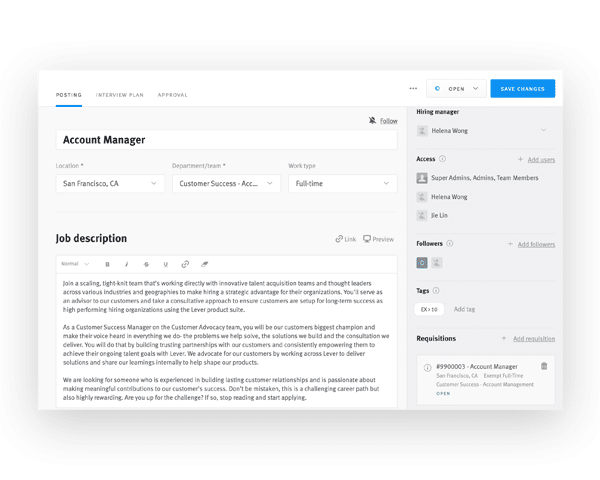
The core elements we’ve just walked you through are important for getting an outline of a job description together. But how can you write impactful and inclusive job descriptions that attract talent while driving diversity recruiting? We’ll show you!
Recruiters and hiring teams know the talent market better than anyone. After all, you’re working to source, engage, and nurture talent every single day—not just new talent, but existing employees, too. With this knowledge, you’re able to provide insights into things like salary expectations, competitor recruiting, internal mobility, and much more.
What about inclusivity, though? From the perspective of diversity, equity, and inclusion (DEI), inclusive job descriptions give further insight into organizational culture and a company’s approach to DEI. If a job description is a candidate’s first real look inside your company, then the description must be inclusive of all.
A diverse workforce benefits everyone—and it’s not just good for your business, it is good business. Let’s consider a few facts about diverse workforces that showcase why diversity recruiting is crucial:
- 67% of employees consider workplace diversity an important factor when considering employment offers with a new company
- Studies have found that anonymized recruiting can help increase the likelihood of hiring more diverse teams, up to 46% when hiring women
- Companies with racially diverse teams tend to outperform others lacking in diversity—up to 35%
- 58% of employees wouldn’t apply to a company where there’s a pay gap
It’s fair to say that diversity recruiting can have a substantial impact on the success of a company—and what better place to start than with your job descriptions? We’re going to walk you through 6 tips to help you write inclusive job descriptions.
1. Start by addressing gender coding in your recruiting messaging
Gender coding refers to signals, such as words, phrases, or traits, that have been historically associated with or attributed to either the male or female gender. Gender coding occurs in recruiting messaging far more often than you may think and can create a false impression as to who the ideal candidate is for a role.
It can be a tough pill to swallow, but if your job descriptions are ‘coded’ too heavily towards any gender, it can influence who does or doesn’t apply, effectively alienating talent right out of the gate—regardless of skills or qualifications.
By addressing gender coding first, you can better craft descriptions and job postings that don’t skew towards a specific gender, even unintentionally.
Take Hypercontext , for example. The company forgoes the traditional ‘fit’ aspect to focus on inclusive language that welcomes all applicants, not just those from specific backgrounds, perspectives, or prescribed genders.
Hiba Amin, Senior Marketing Manager at Testbox
At Hypercontext, we approach job descriptions with internal mobility and external inclusivity in mind. For example, we include language that combats any apprehension candidates have, especially those who would be categorized as POC or womxn. It’s no secret that minorities are less likely to apply to roles that they’re qualified (or nearly qualified) for because we find ways to convince ourselves that there are better candidates out there. That’s definitely been the case for me many times throughout my career. So, to combat this we use excerpts like the following to ensure that our JDs are always inclusive both to internal employees and external candidates.
This leads us to our next point…
2. Use gender-neutral language
We talked about humanizing job descriptions earlier on in this guide, and the same lesson goes for the language you use in your descriptions. While we all have preferred pronouns, leveraging gendered pronouns in job descriptions is a sure-fire way of excluding pools of candidates who may otherwise be qualified for the role. For example, if you’re hiring a Senior Developer, language like, “He will design, code, test, and implement our solutions” gives job seekers the impression that the role is geared towards male applicants. Instead, “You will design, code, text, and implement our solutions” helps you avoid gender bias while also giving the impression that you’re speaking directly to the candidate.
“Gender coding” refers to signals, such as words, phrases, language, or traits, that have been historically associated with or attributed to either the male or female gender. Gender coding occurs in recruiting messaging far more often than you may think and can create a false impression as to who the ideal candidate is for a role.
3. Use inclusive language, too
Gendered pronouns are not the only words that can subtly yet quickly deter candidates from applying to a role. How you phrase your job description can also have an impact—for example, it’s not uncommon for certain terms or job titles (like that example of a ‘Rockstar’ we used earlier) to signal male-dominated cultures, while seemingly harmless language like ‘ambitious’ or ‘competitive’ can alienate women candidates. Being cognizant of how language can implicate bias towards certain groups or genders can help you avoid crafting discriminatory descriptions.
4. Forego requirements and ‘must-haves’
The notion that there is a ‘perfect’ candidate for every role is outdated and disregards a person’s ability to learn new skills, adapt to a new environment, and adopt knowledge as they go. In reality, most of the ‘must-haves’ listed in job descriptions are nice-to-haves or skills that can be learned while in a role. In the case of inclusivity, focusing too heavily on requirements or necessary skills/experience can alienate top candidates.
5. Remember that diversity includes disabilities, too
When focusing on making your job descriptions as inclusive as possible, don’t forget about candidates with physical and cognitive disabilities. It’s not uncommon for a job posting to include language that’s inclusive of age, race, or gender, but exclusive of those with disabilities. For example, stating that a candidate “Must be able to lift 50 pounds” is exclusive, while “Moves equipment up to 50 pounds” removes the ‘how’ aspect and focuses instead on what needs to be accomplished in a role. Ensure your job descriptions aren’t alienating talent with disabilities—seen and unseen.
6. Drop the jargon
Job descriptions littered with jargon (whether industry or company-specific) can be problematic when sourcing talent from different avenues, especially outside of your primary industry. Many candidates have transferable skills from other industries they may assume won’t convert based on the language you use. A rule of thumb is to avoid using jargon altogether, but if you have to—for example, if you’re hiring for a role that requires the use of specific tech or tool types—spell out things like acronyms or describe the jargon in plain speak for candidates.
So far, we’ve covered quite a bit about job descriptions in this guide. But we’re not finished! We want to show you how our teams at Lever approach job descriptions to attract and engage talent, both through inbound and outbound recruiting. Earlier in this guide, we mentioned that we use impact descriptions—and you can, too.
A large part of a job description is the skills needed to perform the job. If you’re only looking at hard skills though, your talent pool significantly decreases. Focusing on soft skills in your job description widens your talent and applicant pool, reduces bias, and can boost retention by attracting candidates that have the soft skills to be successful in their future role.
Let’s take a look at what impact descriptions are, how you can create impact descriptions, and how you can measure their efficacy in your own organization.
Start with an impact description framework
Recruiters practice both inbound and outbound recruiting—and job descriptions are part of these hiring strategies. It’s inevitable that candidates will need a job description, regardless of whether they came to our company through a job posting or your hiring team engaged them through outbound initiatives. But how do you create job descriptions that serve both types of recruiting?
The answer: impact descriptions. With impact descriptions, you can better source, engage, and nurture talent that you want to attract and hire. As both sourcing and nurturing are essential components of talent relationship management, a framework for how you develop impact descriptions can help with inbound and outbound recruiting.
Caitlyn Metteer, Director of Recruiting at Lever
Back in 2014, we came together as a company to determine more broadly what it feels like to be recruited at Lever. Of course, job descriptions were a focal point! We wanted to ensure that, when people read our job descriptions, they were given a holistic understanding of what it would feel like to be part of Lever, as well as that role over the course of their tenure with us. Through that process, impact descriptions were born.
What are impact descriptions?
Job descriptions are one of the least evolved ‘tools’ in a recruiter’s arsenal, not for lack of trying to modernize them, but because they are often focused on the company rather than the candidate.
At Lever, we believe there’s a better, more effective way to leverage job descriptions for recruiting top talent—impact descriptions!
Impact descriptions focus on outcomes, impacts, and performance rather than a rigid set of tasks or responsibilities. In other words, impact descriptions emphasize the impact an employee can have and the contributions they can make instead of focusing solely on what they’ll do in their day-to-day.
Impact descriptions show potential impact and outcomes, whereas job descriptions show requirements and tasks.
When creating impact descriptions, we take an outcome or performance-based approach which identifies two important dimensions of a role:
What is the candidate expected to own, teach, learn and improve once they’re in the role?
What should a candidate accomplish, and when? How will the candidate’s career progress throughout the year?
The first step in creating an impact description is to understand the role you’re hiring for and who your ideal candidate is. Each role you recruit for will inevitably have a desired set of skills, experience, and qualifications, but it’s important to keep in mind that you’re hiring for impact and potential future mobility, not just short-term needs.
Before drafting your first impact description, your hiring team should consider what the candidate will own, and what they’ll improve upon or drive, if hired into the role. Asking questions like, “What will this person be responsible for? What would they be the primary owner of?” is a good place to start.
Impact descriptions must still be inclusive and follow the tone of your company culture. The language you use, and how you create your own impact descriptions, should prioritize diversity and inclusivity.
Match and showcase motivators
Once you understand the role you’re hiring for and who your ideal candidate for the role is, you can move on to the next phase of crafting an impact description: motivators.
Motivators are qualities or opportunities that candidates look for in a role and organization that push them to search for new job opportunities. For example, some candidates are motivated by growth, development, and leadership opportunities, while others see incentives in joining a team where they have more autonomy and stability in their role.
Impact descriptions allow you to showcase these motivators to better align with the type of candidate you want to have apply, versus those that may not be the best fit for the role. Clearly linking these motivators to the role can help your hiring team more efficiently review candidates with aligned motivations.
Get specific (and avoid ambiguity)
The more clear and specific your impact description is around goals, impacts, and outcomes, the better. Traditional job descriptions are intended to ‘weed out’ the wrong candidates for a role, whereas impact descriptions empower you to attract the right people to the right roles and get candidates excited about joining your company.
When drafting your impact description, ensure your needs, expectations, and the role’s potential impacts are clearly defined so that candidates have a firm understanding of what they can accomplish in the role.
Draft your first impact description
Now that you know what role you’re hiring for and why; the ideal candidate you need for the role; the key motivators you’ll showcase, and a few best practices for specificity, you’re ready to write your first impact description.
Focus on providing details around what the candidate can expect to own and drive in the role, and the team they’ll be joining. Remember, you want to avoid lists of tasks and requirements in favor of outcomes and impacts.
Using this framework, recruiters can more effectively communicate not just expectations of a role, but what a candidate can hope to achieve and the contributions they’ll be able to make just within their first 6 months alone.
Evaluating how effective your impact descriptions are can give you insights into how candidates feel about your descriptions and what improvements or updates you can make along the way. Depending on how you share these descriptions—via inbound or outbound recruiting efforts—you may receive feedback from candidates that helps you iterate on the descriptions over time.
Monitor unqualified versus qualified candidates
Receiving a large number of underqualified candidates for a role can indicate that your impact description isn’t defined clearly enough. For example, you may need to better highlight growth opportunities, or more clearly explain your company culture. Similarly, if you’re receiving lots of applications from otherwise terrific candidates who would be better suited for other positions, that may indicate that the outcomes, impacts, and expectations in your descriptions aren’t clear.
In this case, you’d want to pay close attention to conversion rates as a key recruiting metric.
One quick way to determine whether your impact descriptions are driving your desired recruiting objectives is to look at conversion rates. For instance, recruiters with Admin status in LeverTRM can monitor overall application trends via Lever’s Conversion Rates report. The recruiter can hover over the percentage of candidates archived in the New Applicant stage to see why a candidate didn’t move forward.
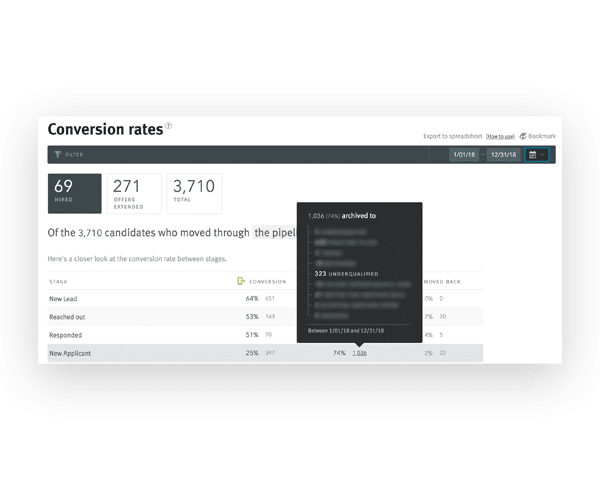
Finally, collect feedback from candidates and hiring teams alike
If your recruiters are as obsessed with data as we are, then you’re likely already collecting insights from candidate feedback and input from your hiring team. When using and consistently improving your impact descriptions, close the feedback loop between your candidates, your hiring managers, and your recruiting team! Here at Lever, for example, we send candidate feedback surveys to applicants and make sure to flag and record feedback so that our recruiters can see how candidates are reacting and where we can make improvements.
Collecting feedback from candidates is crucial to consistently improve your recruiting process. At Lever, for example, we share feedback surveys with candidates that ask them about their entire experience, from applicant to interviewee and beyond.
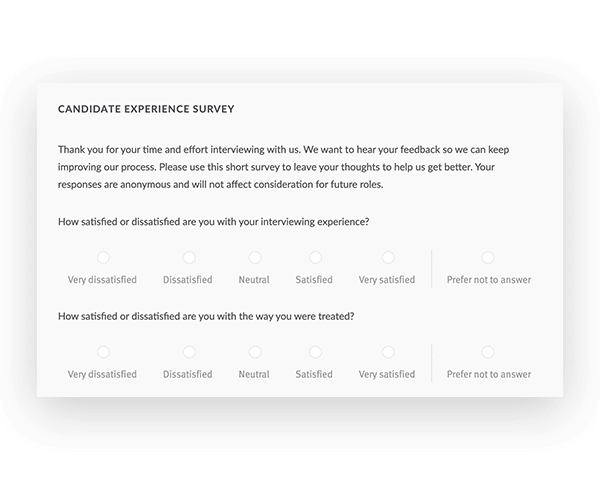
If you’re ready to transform your everyday job descriptions into impact descriptions that drive results for your recruiting, download our free impact description guide. You’ll get our top tips for crafting the perfect description and have everything you need to attract candidates and nurture top talent for your organization.
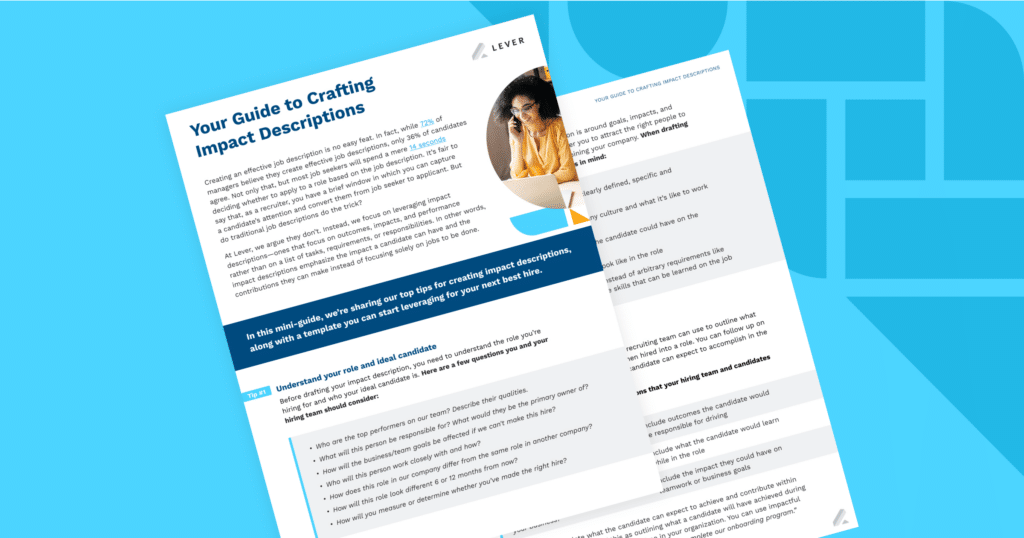
Your Guide to Creating Impact Descriptions
- 800+ Job Description Templates
- Content Team
- Technical Writing Manager Job Description
Use the Technical Writing Manager job description template we built to scale a content team to 45 writers and editors. Building a content team? Join the largest Content Ops community (3,000+ members) on the internet.

Gordana Sretenovic
I grew a team from two to forty five talented people, in just eighteen months. Systems, processes, and people.
Written by Gordana Sretenovic
Hire the Top 1%
Join hundreds of ambitious companies using skills tests to identify and hire the top 1% of your job applicants.
Table of Contents
Responsibilities , requirements, salary ranges for technical writing manager s, customize the technical writing manager job description to suit your company needs, similar roles to technical writing manager s , get more technical writing manager job description inspiration, finding a qualified editing manager is difficult—unless you use pre-hire assessments, minimize manual work with workello’s automated pre-employment tests, technical writing manager job description template.
Do you have extensive experience in technical writing and excellent managerial skills? We’re looking for a Technical Writing Manager to help us build and mentor a team of technical writers.
In this role, you will review the work of our technical writing team, ensure that all content meets the standard documentation requirements, guide writers on creating sophisticated technical documentation, and ensure the content department milestones are met . Our end goal is to ensure our technical documents are written in a concise and easy-to-understand manner.
The ideal candidate possesses both solid technical writing skills and team management experience.
- Supervising and mentoring our team of technical writers and providing feedback on their daily work
- Helping us update the strategies for creating, maintaining, and delivering excellent technical documentation
- Updating quality guidelines and ensuring that all technical writers adhere to the company’s standard documentation procedures
- Ensuring that the weekly and monthly goals for the technical writing department are met according to our content calendar
- Maintaining, organizing, improving, and updating the existing technical documentation
- Excellent writing, editing, and communication skills
- At least three years of experience in a technical writing position and at least one year of experience in a managerial role
- Experience in growing a team of writers is a plus
- Superior attention to detail
- Ability to communicate effectively with people who possess different levels of technical knowledge
- Passion for quality, design, and great user experience
The salary of a Technical Writing Manager can vary depending on the candidate’s location, level of experience, or the hiring company.
Check out the following table to see the average annual salaries of Technical Writing Managers across different cities in the U.S., according to Glassdoor :
When writing the job description for your Technical Writing Manager job ad, it is important to customize it according to the requirements of your company and editorial team . That will help you avoid receiving and reviewing portfolios and resumes from candidates who are not ideal for the position. For instance, technical writers without any managerial experience probably will not be a good fit for this role. While Technical Writing Manager s are great writers, the focus of this position is building and managing a team of technical writers. They take responsibility for the timely delivery of technical documents and are always looking to improve productivity.
You can personalize the job description by evaluating your company needs and listing the following:
- Niche requirements —Specify the niche in which the Technical Writing Manager should have experience in, for instance, finance, medicine, or sports
- Duties —Indicate the exact duties the successful candidate will perform in your company, depending on the structure of your content team. You can ask yourself, for example, whether the manager will have to jump in occasionally and write technical documents too?
- Types of technical documents —Mention whether the candidate should have experience overseeing and creating all types of technical documentation or just one particular type—user/instruction manuals, project plans, scientific papers, or white papers
Not sure if a Technical Writing Manager is the best fit for the needs of your team? Check out our job description templates for similar roles to evaluate the option that fits your company needs better:
- Content Manager
- Writing Production Coordinator
- Senior Writer
- Content Marketing Manager
- Content Director
- Content Curator
- Content Delivery Manager
- Chief Content Officer
- Content Director in Sports Media
- Commerce Editor
- Senior Content Marketing Manager
- Content Quality Analyst
- B2B Content Manager
- Content Analyst
- Sports Social Content Manager
Looking at how other companies that are hiring Technical Writing Managers market themselves can help you put together a description that attracts only the highly qualified candidates . Here’s a list of major online job boards where you can find the latest Technical Writing Manager job description examples :
- SimplyHired
Learn how to lower your content cost by 50% and hire top talent
Hiring a senior member of your editorial team is a step above hiring an editor. They must possess certain skills that go beyond editing capabilities, and you’ll find hundreds of applicants on every job board that want to make the step up without the skill set to back them up.
The problem is, everyone can pimp their portfolio and prepare the right answers for an interview. The most efficient method of selecting the best candidate is through pre-hire testing .
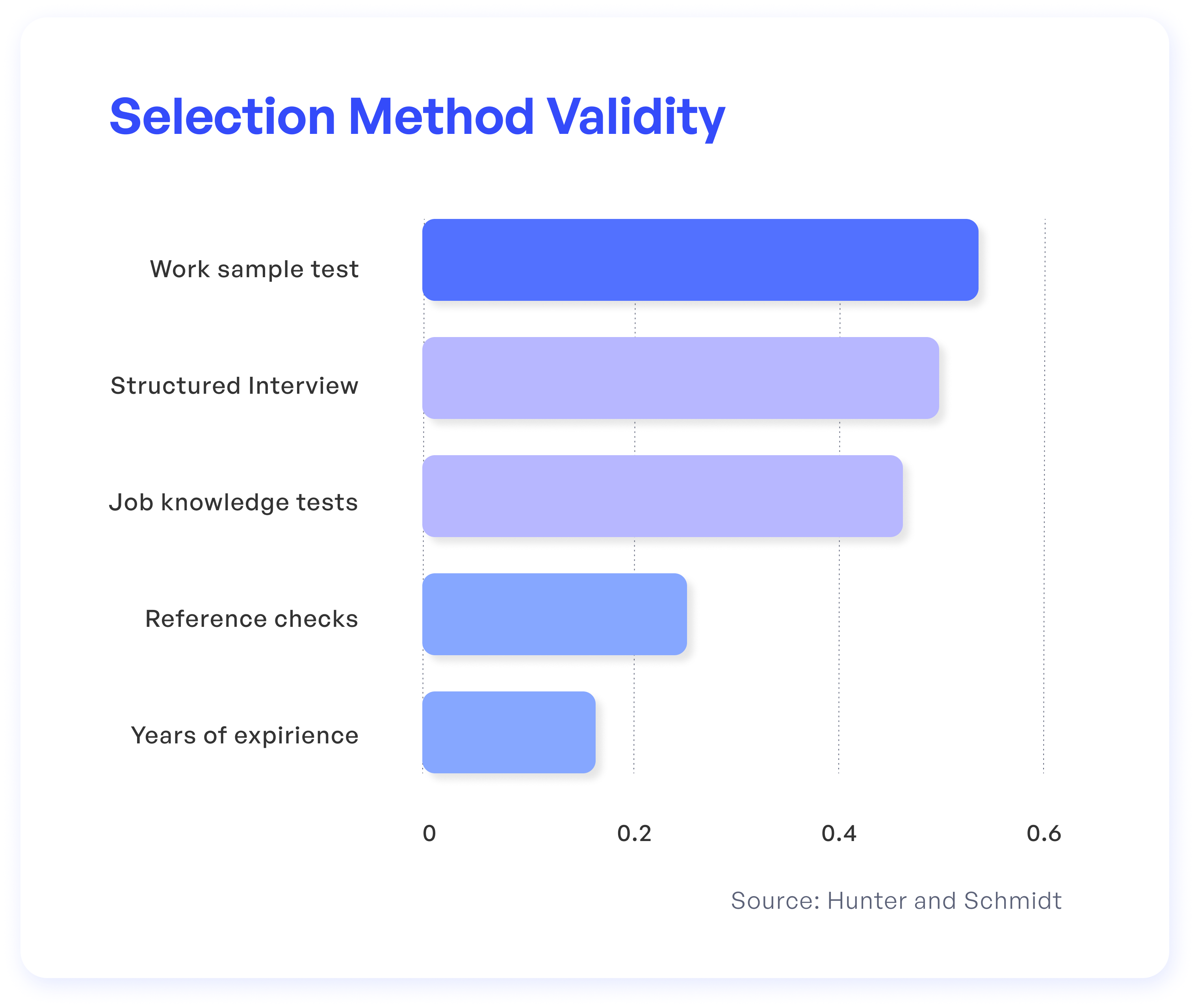
Another issue is—if you start sending out tests to hundreds of candidates manually, how do you keep track of them? You can’t—but skill assessment software can do that for you with ease. Workello helps you automate and optimize your hiring funnel, and you’ll find the perfect match in five easy steps:
- Sign up for free and use pre-configured settings to set everything up in under 90 seconds
- Post a job ad on various job platforms and link your Workello job post
- Watch as applications start flying into your dashboard
- Test candidates to quickly spot unqualified applicants with great resumes
- Reject candidates, interview them, and extend contract offers with a single click
With Workello, you won’t need any other recruiting solutions. It’s all-in-one high-volume recruiting software that will help you test content marketers , content writers , technical writers , SEO writers , and SEO copywriters with ease.
All you need to do is move candidates through the funnel with a single click, and you’ll automatically assess, test, interview, and hire the best ones. You can create a free account and see how the fastest pre-hire assessment works with Workello.
Hire the Best of the Best
Join hundreds of ambitious companies using skills tests to identify and hire the top 1% of their job applicants. Signup and start accepting new applicants in 3 minutes.

Case Studies

Most Recent Content Team Job Descriptions
Hire the top 1% on auto-pilot.
7 Examples of a Manager Job Description Template [+ 1 free to copy/paste]
700+ people search for some variation of “manager job description template” on Google every month. In this blog, you’ll find:
- the definition of “manager”
- 7 examples of manager job descriptions
- a free copy/paste template to help you write your own manager JD
Note: I ran the job postings through Ongig’s Text Analyzer software to ensure they score over 80% or more (out of 100), are gender-neutral, AND have no other exclusionary language (based on race, age, disability, sexual orientation & more).
What is a Manager?
A manager is someone who:
- takes on a leadership role in an organization
- coaches and manages a team of employees
- handles the day-to-day operations of a department
- conducts performance reviews
- makes desicions for their department
- acts as a line of communication with high-level execs
7 Examples of a Manager Job Description Template
I found hundreds of manager job description templates. I list 7 of the most searched (and well-written) to give you some ideas on what to include in your JDs (e.g., duties, salary, benefits, diversity commitment, etc.)
Sales Manager Job Description Template — Salesforce
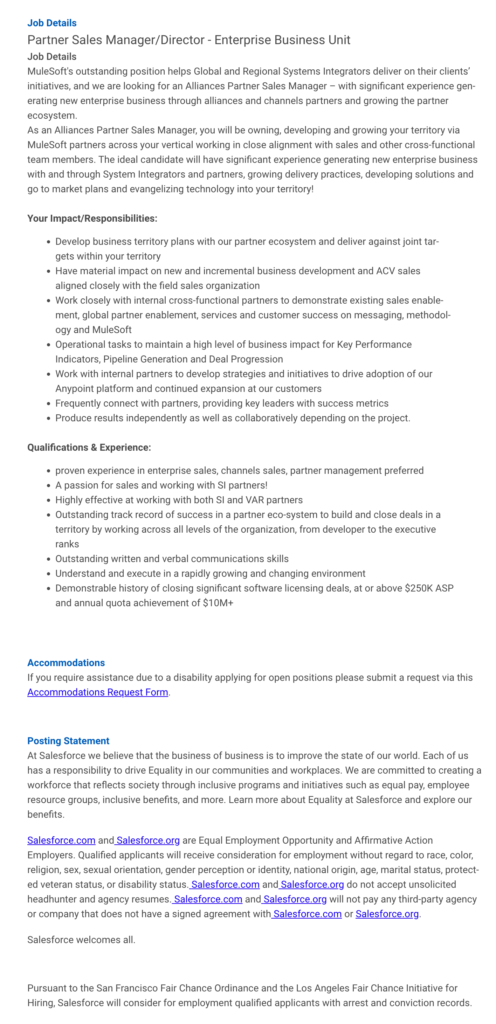
HR Manager Job Description Template — Blizzard Entertainment
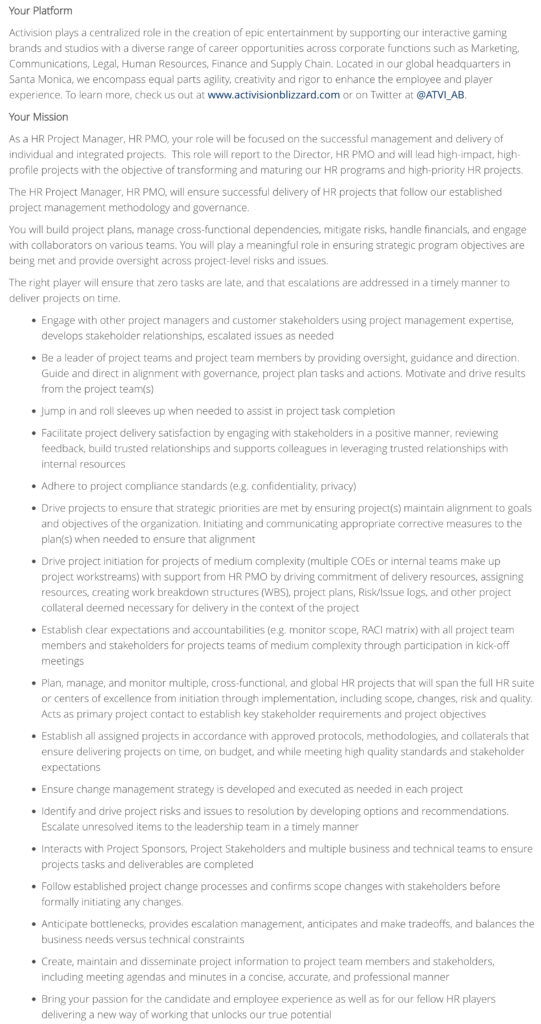
Finance Manager Job Description Template — Mercedes-Benz AutoNation
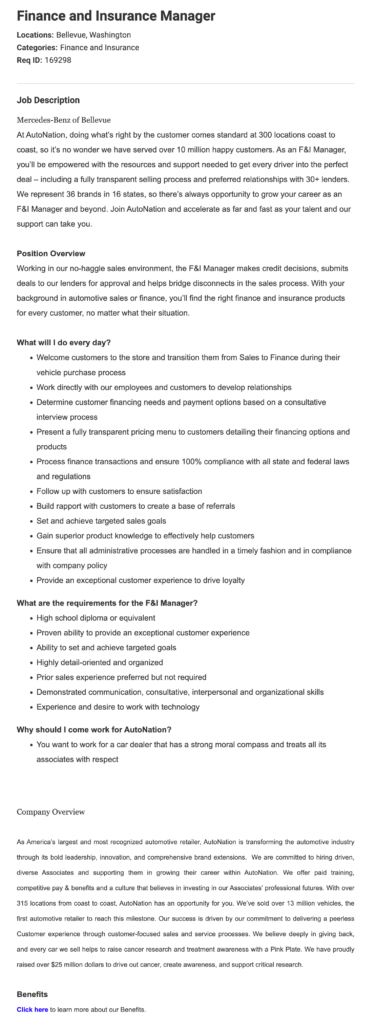
Accounting Manager Job Description Template — Pinterest
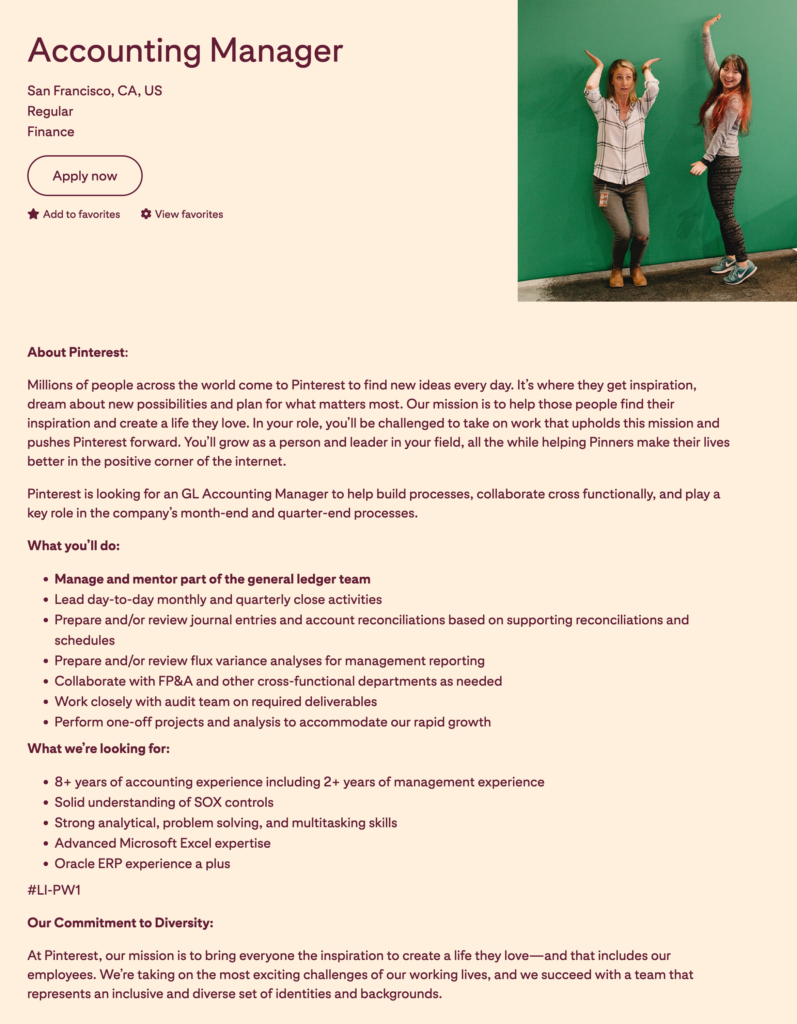
Job Description Template Operations Manager — Better Talent


Restaurant Manager Job Description Template — The Grand Hotel

General Manager Job Description Template — CEVA Logistics
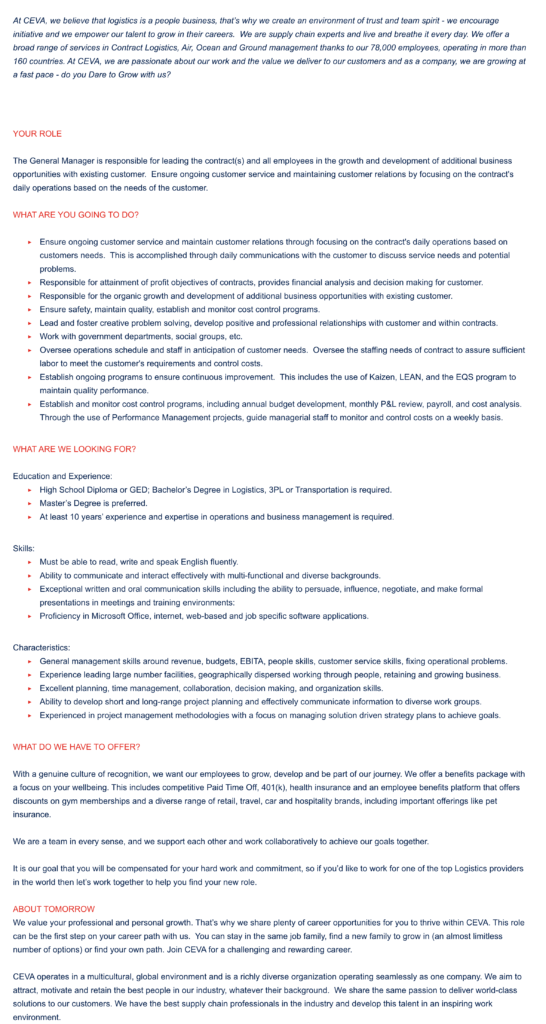
Free Manager Job Description Template [just copy & paste!]
Ready to write? The 7 manager job description templates above are a great place to start. Or try using this operations manager job description template as your guide. I’ve listed tips and examples so you can easily copy/paste.
Note: This template works for any management role. Just include the correct title, e.g., Finance Manager, Project Manager, Restaurant Manager .
[Here, include the word manager and any other important part of the position, e.g., “operations”]
Tip: Keep your job titles between 1-3 words and 20 syllables or less. This helps with SEO and makes them easier to read. For example, “Operations Manager” is better than “Operations Manager, Remote Full Time.”
JOB SUMMARY
[This is where you write a paragraph about the role.]
Tip: A manager job summary should concisely explain the role. Remember to include who they’ll supervise and any other manager-level responsibilities. This often increases job satisfaction.
Here’s an example for inspiration:
“As the Finance Systems Manager – EPM, you will be responsible for owning, and enhancing our Adaptive Planning instance. You will work closely with the finance leads, accounting, and financial platform teams to implement new models, expand our current reporting capabilities and build new data connections to systems including Workday, Netsuite, and Snowflake.”
[This is where you talk about your manager candidate.]
Include a sentence on:
- what the manager will do
- some goals they will reach for
- how they work with or supervise the team (or other teams)
Tip: You can use the manager job descriptions above for inspiration.
WHAT YOU’LL DO
[Here is where you list the day-to-day manager job duties.]
Job duties may include:
- Manage day to day client support
- Facilitate a collaborative team environment
- Provide ongoing support for new projects
- Coach direct reports
- Work with C-suite for strategy planning
Tip: Keep your “responsibilities” and “manager job duties” lists short. Using more than 7 bullets might make candidates feel underqualified or overwhelmed.
YOUR REQUIREMENTS
[This section is where you list basic manager qualifications and experience.]
Tip: Include your preferred requirements here or create a “Preferred Requirements” section if there are more than two.
[List the salary or hourly rate for the role here. Candidates spend more time looking at it than anything else.]
Tip: Even if it’s a range, list salary details. Salary is the #1 part of a job ad that is “helpful”, “appealing”, and makes candidates “more likely to apply”.
source: Vision Critical Heatmap Study of 450 LinkedIn Members, June 2018
[List any perks your manager will get if they join the team.]
Tip: Each benefit you include in a job ad increases the apply rate by 1% to 5%. The benefits with the most positive impact on apply rate are: Regular Incremental Bonus (+155.1%); Pet Insurance (+37%); Health Insurance (+29.8%); Stock Options/Employee Stock Purchase Plan (+27.5%); and 401(k) (+20.5%).
source: Appcast and Behavioral Scientist Ashley Whillans, PhD, Harvard Business School, 2018
OPTIONAL SECTIONS
[These are some optional sections you might use in your job description for a manager.]
- travel requirements
- remote work policies
- disability accommodations
- how to apply
[Here, you talk about yourself!]
Some ideas to include:
- what type of healthcare you provide
- how great the company is
- your core values
Tip: I like to save the “About Us” section for the end (even though about 50% of JDs start with About Us). Instead, end your JD with the About Us. That way, you can START your JD about the candidate/role, making them feel valued.
DIVERSITY STATEMENT
[Most companies have an EEO or diversity statement. You can put yours here.]
Tip: Most candidates value seeing a D&I commitment. A diverse population of 764 LinkedIn members in the U.S. said “even a generic statement is still better than no statement.”
source: LinkedIn Study of 764 members on Diversity Statements, June 2021 .
You’ll find more examples in our blog 25 Examples of Awesome Diversity Statements .
Why I wrote this:
Ongig is on a mission to help you attract top talent by crafting effective and inclusive job descriptions. Using the template builder feature, you can store your most-used JD templates so there’s no confusion when creating new roles. Request a demo to learn more.
Shout-Outs:
- What Is a Manager? Definition, Role and Responsibilities by Indeed Editorial Team
February 16, 2022 by Heather Barbour in Job Descriptions
- AI Recruitment (1)
- Applicant Tracking System (16)
- Candidate Engagement (10)
- Candidate Experience (5)
- Company Career Site (42)
- Conferences (18)
- Diversity and Inclusion (239)
- Employee Branding (3)
- Employer Branding (42)
- Employer of Choice (4)
- Entrepreneurship (4)
- Hiring (27)
- HR Content (64)
- Job Boards (2)
- Job Description Management (7)
- Job Descriptions (152)
- Job Pages (3)
- Job Postings (9)
- Job Titles (44)
- Leadership (4)
- Microsites (6)
- Networking (5)
- Recruit Veterans (1)
- Recruiters (18)
- Recruiting Metrics (2)
- Recruiting Process (7)
- Recruiting Software (13)
- Recruiting Strategies (32)
- Recruiting Videos (12)
- Recruitment Marketing (10)
- Recruitment SEO (9)
- Social Recruiting (21)
- Talent Acquisition (9)
- Talent Airport (2)
- Technology (8)
- Trends (11)
- University Recruiting (3)
- Video Job Descriptions (9)
- Writing Job Descriptions (40)
template: single.php

Stay informed with our news, tips and resources designed to help you be successful in your mission.
How to Write a Development Director Job Description: 4 Key Tips

A development director is essentially the captain of your organization’s fundraising ship. Without an experienced professional in command, chances are your funding and overall management will suffer.
To keep your nonprofit’s operations afloat, it’s imperative that your nonprofit seek out a born leader and expert philanthropist with a well-rounded development director job description.
Typically close partners with the executive director and major gift officer, your development director’s chief priority is to design and execute a killer fundraising game plan for your organization.
With so many duties on a development director’s shoulders, it’s understandable why your nonprofit’s executive search team may have trouble constructing an informative and inviting job post.
Thankfully, we’ve mapped out the essential elements in a development director job description for you to draw in top candidates with ease, including:
- A development director job description template.
- Development director key responsibilities.
- Development director job requirements.
- Where to post your development director job description.
No matter what your cause or community may be, these job description tips will ensure your organization finds the right development director to champion your philanthropic goals.
But before starting your search for a new executive director, ask yourself this, “Do you have a solid transition plan in place?” Implementing a transition plan ensures that your new director has all the tools they need to succeed. Learn more with our comprehensive guide .
Development Director Job Description Template
Due to the adaptable nature of a development director’s role, it’s easy for your nonprofit’s job description to become disorganized and overstuffed with information.
Make sure your job description stays on a clear and coherent path by taking inspiration from the following development director job description example.
Columbus Learning Institute Seeks Development Director The Columbus Learning Institute seeks a full-time development director to head our ongoing fundraising and operational needs. Reporting to the executive director, this professional must have an established background in coordinating nonprofit donation strategies and staff/volunteer leadership. This role involves organizing large-scale fundraising initiatives, working with board members, managing our annual fund and building relationships with donors, staff and volunteers. The development director will also assist our major gift officer with implementing major giving and planned giving fundraising strategies. Our ideal candidate will have a bachelor’s degree and a minimum of five years of fund development experience, preferably in the education and nonprofit fields. They should also be familiar with CRM nonprofit software, donor databases and other fundraising technology to use in their daily job duties. Applications will be accepted through October 31 and early submissions are encouraged. Please send application materials (resume, cover letter, references and salary requirements) to [email protected].
This job description example is simple yet thorough in explaining the multi-functional executive role of the development director job opening.
If you would rather draft your development director job description using an alternative letter format, no worries! Simply check out DonorSearch’s free template and top tips for finding your nonprofit’s next executive leader.
Development Director Key Responsibilities
Your development director will most likely tackle a range of responsibilities all rooted in long-term fundraising (like capital campaigns) , annual fund management and donor stewardship.
Luckily, the role of a development director can be molded to fit your organization’s exact needs. For instance, while a smaller nonprofit may enlist a volunteer to take on the job, another nonprofit may find more value in delegating a development director’s responsibilities to other executive leaders.
That being said, the development director role is certainly widespread enough to warrant a specific individual or team to manage all ongoing work.
Here are some of the main tasks that should fall to your nonprofit’s development director:
- Planning and evaluating fundraising campaigns and activities.
- Managing the organization’s budget and fundraising income programs.
- Identifying and stewarding prospective donors.
- Recruiting and training fundraising staff and volunteer leaders.
- Staying on top of fundraising trends and the nonprofit community.
It’s also important to clarify in your job post the everyday activities your development director will handle such as:
- Communicating with donors and staff via email, phone or social media.
- Answering donor and staff inquiries in a timely fashion.
- Using prospect research tools and your donor database to build donor relationships.
- Creating solicitation materials for the fundraising team.
Overall, the ability to multi-task and connect with people are valuable qualities that should be emphasized in your development director job description.
Development Director Job Requirements
Due to the versatile nature of the development director position, it’s not unusual for necessary job qualifications to vary between organizations. After all, your nonprofit’s unique objectives will most likely require the assistance of a tailored development director professional.
For ideas on what education, experience and primary skills to look for, follow along with us below.
1. Education and Experience Levels
As a top representative of your organization, it’s customary for your development director to meet greater expectations than other nonprofit staff . However, when it comes to analyzing a development director’s education and experience, the latter item should definitely be taken into higher consideration.
While a bachelor’s degree is essential, additional degrees and certificates may also be beneficial depending on the sophistication of the organization and its fundraising program.
Regardless, your nonprofit should focus more on your candidates’ fund development and team leadership experience in a nonprofit or career-related setting.
Your organization can prioritize this key information in your job description by asking applicants to detail notable fundraising planning, training and executing experience in their cover letter or application materials. Encourage them explain how their past fundraising experience will benefit your nonprofit and help them transition into your development director position.
2. Top-billed Skills in a Development Director
Your development director job description is also the perfect place to highlight ideal fundraising and technology skills that will set your applicants apart.
By taking note of specific skill sets early on, your organization can more efficiently review applications that not only meet your development director guidelines but rise above them.
Take a look at our top suggestions for preferred development director skills below:
- Superb written, verbal and interpersonal skills.
- Time management and flexibility with job duties.
- Fundraising software and tools expertise.
- Creative, self-starter attitude.
- Donor and volunteer service mentality.
- Organized and inspiring team leader.
These exemplary skills are most effectively outlined in a job description downloadable resource attached to your online job board post.
Where to Post Your Development Director Job Description
Speaking of job boards, now that your development director job description is ready to go, it’s time to move forward with marketing your job opening online to qualified individuals.
A great place to start is by surveying leading nonprofit job boards to see which platform and pricing package best fits your needs and budget. While mainstream job search engines like LinkedIn and Indeed are tempting, we also encourage you to check out local nonprofit job boards to target ideal applicants in your area.
For example, did you know Aly Sterling Philanthropy posts local nonprofit job description to help nonprofits on this journey?
In addition to exploring regional options, other virtual nonprofit job boards we recommend include:
- CFRE International — This online career center offers one-of-kind employer services and job postings from around the world.
- The Chronicle of Philanthropy — A nonprofit magazine, this publication features grants, resources and a virtual job board.
- Idealist — Visit this website for national nonprofit job and volunteer listings for English and Spanish-speaking applicants.
You can also search for resources that provide job posts related to your organization and industry. Let’s take a look at these education, healthcare and nonprofit-related examples:
- The National School Foundation Association (NSFA) — This academic association supplies education fundraising resources and job posts for teaching and administrative positions.
- Association for Healthcare Philanthropy (AHP) — A healthcare alliance, this organization features education and career development services, including an online job center.
- Ohio Association of Nonprofit Associations (OANO) — This nonprofit ally promotes education, advocacy and widespread career opportunities in the Ohio nonprofit sector.
- Charitable Advisors (of Indianapolis) — Visit this website for nonprofit consulting services and resources as well as a one-stop job portal for Indianapolis-based job seekers.
Another best practice is to prominently display the following details at the top of your development director job description in order to immediately attract a job hunter’s eye:
- The official job title.
- Your nonprofit’s name.
- The application deadline.
- Salary/compensation.
For a firsthand look at what a development director job description should prioritize, check out this example of a downloadable resource paired with an online job posting.
As a separate document, this resource can be easily printed and shared. Furthermore, the branding connects the applicant to the cause and the extra space gives a nonprofit the opportunity to expand on their mission and location.
A development director symbolizes many things about a nonprofit organization, like your creativity, work ethic and reputation to name a few. Start your executive search off right with a master development director job description that successfully draws in your top percentage of contenders.
For more on nonprofit hiring and executive search, check out these additional resources:
- How to Write a Major Gift Officer Job Description: 4 Must-Know Tips — Explore our strategies for creating an inviting and effective major gift officer job description.
- Hiring a Fundraising Consultant: 12 Essential Tips — If you’re doing a complete overhaul of your nonprofit’s strategy in addition to hiring new executives, you may decide to enlist the help of a fundraising consultant. This guide will show you how!
- 7 Tips for Hiring a Top-Notch Development Expert — Before you draft your development director job description, check out Qgiv’s essential tips for hiring this key executive player.
A development director is essentially the captain of your organization’s ship, and without an experienced nonprofit professional in command, chances are your overall funds and management might suffer.
For more executive search best practices tailored to your local nonprofit needs, hop on over to Aly Sterling Philanthropy’s top four regional executive search locations .
For example, did you know Aly Sterling Philanthropy posts local nonprofit job descriptions for their executive search clients ?
You can also search for resources that provide job posts related to your organization and industry. Let’s take a look at these education, healthcare and nonprofit-related examples.
As we noted earlier, it also never hurts to pair a downloadable resource with your online job description to further expand on the exact qualities you’re seeking.
On the other hand, if your organization prefers to connect with nonprofit professionals directly, you can always work with an executive search firm to craft a customized job description.
- Hiring a Fundraising Consultant: 12 Essential Tips — For nonprofits looking to bring on an executive search consultant, take a moment to review the hiring process first with our in-depth guide.
Recent Posts
- Hiring an Expert Capital Campaign Consultant: 6 Simple Steps
- Secrets to creating your best case for support – Part 2
- How to Build Strong Member Relationships: 4 Nonprofit Tips
- Secrets to creating your best case for support – Part 1
- Corporate Philanthropy: The Secret to Maximizing Your Impact
- Board Catalyst
- Corporate Philanthropy
- Fundraising Best Practices
- Fundraising Solutions
- Nonprofit Job Postings
- Nonprofit Succession Planning
- Philanthropic Advising
- Strategic Planning
The Nonprofit Store
We created these DIY tools to help you raise more money and grow your mission. They are built on best practices and designed to level the playing field for nonprofits of all shapes and sizes – including yours.
Learn more and shop
The Ultimate Executive Director Job Description (Free Template)
by Joan Garry

Let’s say you’re a board member for a nonprofit organization in need of a new Executive Director. You sit down, armed with coffee and determination, ready to craft the perfect nonprofit executive director job description.
You know that finding a new Executive Director can be quite the adventure, but writing a job description that’s effective, engaging, and true to your organization’s spirit is no small feat. Don’t worry! I’m here to support you with a free template to help make writing a strong nonprofit executive director job description a breeze.
But first, let’s chat about why I felt so compelled to create this one-of-a-kind executive director job description template. You see, there are five critical issues that plague nonprofit job descriptions:
- Leadership transitions are bumpier than a cross-country road trip in a jalopy. And they take soooo long too. While some bumps are just part of the package, we can speed up the process by not obsessing over every little detail in the job description.
- A fantastic job description isn’t just a grocery list of “whats;” it’s a marketing tool that woos top-notch, diverse candidates to your organization’s doorstep. Don’t just focus on tasks; make it sing!
- Nonprofit executive job descriptions often read like they’re for a corporate CEO. Let’s not forget the passion for the mission that makes the nonprofit sector so unique!
- Job descriptions can be unintentional gatekeepers. My own first executive director position required fundraising experience, which I didn’t have. Did that stop me from applying? Heck no! But not everyone shares my chutzpah .
- Skills and experience aren’t everything. I was asked to interview for that first position because I had qualities the search committee believed would make me a successful fundraiser . Job descriptions should focus on key attributes, not just the “whats.”
I’m a problem-solver at heart, and these five issues had me itching to make a difference. So, I crafted a template to tackle these job description pitfalls.
–> DOWNLOAD THE ULTIMATE JOB DESCRIPTION TEMPLATE FOR AN EXECUTIVE DIRECTOR HERE
This template may look different from others you’ve seen and might not be a perfect fit for every organization. Feel free to add or remove items as needed, but it should help you get started.
I truly hope this template aids you in your journey. If you’re about to write an executive director job description or are part of a search committee, I hope this sparks a shift in your thinking, encouraging you to focus on the unique qualities that will lead to a fantastic hire. Good luck, my nonprofit comrades!
Related posts

What It’s Really Like to Be A Nonprofit Executive Director

Corporate to Nonprofit: The Executive Director Interview

“Nonprofits Are Run Worse Than Corporations…” (and Other Harmful Myths)
About Joan Garry
Joan Garry is an internationally recognized champion for the nonprofit sector and a highly sought after executive coach for CEOs of some of the nation’s largest orgs. She is called upon by large organizations to tackle substantial change management / crisis management / leadership transitions requiring a compassionate truth-teller, a hands-on strategy advisor, a communications expert, and a focus on strong internal and external messaging. She is also the founder of the Nonprofit Leadership Lab.
© Joan Garry Consulting 2024
Job Description for Directors: Sample, Tips & Templates

Here’s the deal: directors are the unsung heroes steering the ship of a company toward success. If you’ve ever wondered about the pivotal role these leaders play in shaping the destiny of an organization, you’re in the right place.
In this blog post, we’re unraveling the intricacies of the “Job Description for Directors.” It’s more than just a set of tasks; it’s a roadmap to directorial excellence. So, whether you’re an aspiring director eager to understand the expectations or a seasoned professional looking to refine your approach, this post is your go-to guide.
From defining the fundamentals of directorship to exploring the skills, qualifications, and responsibilities that define success, we’re leaving no stone unturned. The journey begins now, and by the end, you’ll not only grasp the intricacies of the directorial role but be inspired to navigate these waters with confidence.
Ready to embark on this insightful voyage? Let’s uncover the nuances of what it truly means to be a director and set sail into the world of leadership excellence. Keep reading because, trust me, the best is yet to come!
Chapter 1: Director Fundamentals
Chapter 2: director skills and qualifications, chapter 3: director responsibilities, chapter 4: director growth and advancement, chapter 5: director job description, chapter 6: tips for becoming a successful director.
Let’s dive into the exciting world of directors! Ever wondered what it takes to steer the ship of a company or organization? In this chapter, we’ll unravel the fundamentals that define the role of a director. From understanding who directors are to exploring their pivotal responsibilities, we’re set to embark on a journey that demystifies the essence of this influential position.
What is a Director?
At its core, a director is the strategic visionary, the orchestrator of success, and the captain of the corporate ship. Picture this: if a company were a grand production, directors would be the directors (pun intended), ensuring that every actor knows their lines and the show runs seamlessly.

Now, let’s peel back the layers. Directors are the guiding force at the top echelons of an organization. They’re not just decision-makers; they are visionaries who plot the course for the entire team. Directors aren’t confined to one specific area; their influence ripples through every department, setting the tone for the entire organizational symphony.
Directors are individuals with a wealth of experience, honed leadership skills, and a keen strategic mindset. They’re not just managing day-to-day affairs; they’re shaping the long-term trajectory of the organization. Think of them as navigators, steering the ship through the unpredictable waters of the business world.
In the corporate realm, directors often occupy seats at the board level, shaping policies, driving growth, and ensuring the organization’s overall well-being. They’re the visionaries who turn abstract goals into tangible realities, orchestrating success by aligning teams toward a common purpose.
Directors aren’t cookie-cutter figures; they come in various forms and titles, each with its unique set of responsibilities. Whether it’s an Executive Director providing executive leadership or a Functional Director specializing in areas like finance or marketing, the role adapts to the organization’s needs.
So, buckle up! In the upcoming sections, we’ll unravel the intricate layers of a director’s responsibilities, the skills that set them apart, and the roadmap to becoming an influential director in the corporate landscape. Ready to navigate the directorial waters? Let’s set sail!
What are the key responsibilities of a Director?
Before we plunge into the intricacies of a director’s daily grind, let’s take a brisk walk through the primary responsibilities that adorn this prestigious role. Now, I won’t keep you waiting – let’s get straight to the point.
In a nutshell, directors are the architects of organizational success. They don’t just sit at the helm; they actively shape the company’s destiny. Here’s the essence: directors are entrusted with steering the ship in the right direction, ensuring every department functions harmoniously to achieve overarching goals.
1. Strategic Visionaries.
Directors are the visionaries who set the compass. They’re responsible for crafting and executing strategies that align with the organization’s long-term goals. Think of them as chess masters, anticipating moves and positioning the organization for success.
2. Decision-Making Dynamo.
When the stakes are high, directors are the decision-making dynamos. From pivotal business strategies to day-to-day operations, directors play a pivotal role in ensuring that the organization moves forward with purpose and precision.
3. Leadership Luminary.
Leadership isn’t just a part of the job; it’s the heartbeat of a director’s role. They inspire, motivate, and lead teams toward shared objectives. A director’s leadership style shapes the organizational culture, fostering an environment where innovation and excellence thrive.
4. Stakeholder Stewards.
Directors are the bridge between the company and its stakeholders. They cultivate relationships with investors, partners, and the broader community. Balancing the needs of diverse stakeholders, they navigate the delicate dance of maintaining trust and ensuring sustained growth.
5. Risk Mitigators.
In a world of uncertainties, directors are the risk mitigators. They assess potential pitfalls, devise contingency plans, and steer the organization through choppy waters. Adaptability and foresight are their tools for ensuring the ship stays on course, no matter the challenges.
Why is the Role of a Director Important in an Organization?
Now that we’ve glimpsed into the multifaceted responsibilities of a director let’s uncover the critical question: Why does their role matter so much in the grand scheme of an organization? Buckle up; this is where the real voyage into the significance of directors begins.
Picture a director as the architect crafting the blueprint of a skyscraper. They’re not just overseeing; they’re designing the very structure that defines the organization. Their decisions ripple through every level, influencing the culture, strategy, and success of the entire enterprise.
At the heart of it, directors are strategic pioneers. They chart the course for the company, ensuring that every move aligns with the overarching goals. This strategic vision isn’t just a luxury; it’s the compass that guides the organization through the ever-evolving landscape of the business world.
Innovation doesn’t happen in a vacuum; directors are the driving forces behind it. They create an environment where creativity flourishes, pushing teams to think outside the box. In doing so, directors propel the organization forward, staying ahead in a world where stagnation is the antithesis of success.
A strong organizational culture doesn’t happen by chance; it’s cultivated by directors. They set the tone, fostering an environment where values, ethics, and excellence aren’t just buzzwords but integral components of daily operations. This culture becomes the organization’s DNA, influencing every decision and action.
Directors are the tightrope walkers of stakeholder management. Juggling the interests of investors, employees, customers, and the broader community, they maintain a delicate balance that sustains the organization’s reputation and ensures its longevity. It’s a high-stakes balancing act that requires finesse and foresight.
How to Become a Director?
So, you’ve caught a glimpse of the dynamic world of directors, and now you might be wondering, “How do I join the ranks of these influential leaders?” Fear not; we’re about to unfold the roadmap to becoming a director, charting a course from aspiring professional to the helm of an organization.
Becoming a director is not just about climbing the corporate ladder; it’s about strategic moves and intentional career choices. Start by setting clear career goals. Identify the skills, experiences, and knowledge required for a directorial role in your industry.
Directors are lifelong learners. Stay ahead in your field by investing in continuous education. Attend workshops, earn certifications, and pursue advanced degrees if necessary. Directors are not just experts in their domain; they’re visionaries who understand the broader business landscape.
Leadership is the cornerstone of a director’s role. Hone your leadership skills by seeking out leadership opportunities within your current role. Take the initiative, lead projects, and showcase your ability to inspire and guide teams. Directors are not just managers; they are inspirational leaders.
Networking is more than just swapping business cards; it’s about building meaningful relationships. Attend industry events, connect with professionals in your field, and seek out mentors who can provide guidance. Directors often emerge from a network of professionals who recognize their potential.
Directors wear many hats, and gaining diverse experience is key. Don’t pigeonhole yourself into one specific role. Seek opportunities to work in different departments, take on cross-functional projects, and broaden your skill set. Directors bring a wealth of experience to the table.
Types of Directors
Now that you’ve set your sights on the directorial horizon, it’s time to explore the diverse landscape of directorial roles. Directors aren’t a one-size-fits-all; they come in various flavors, each with its unique set of responsibilities. So, let’s unravel the tapestry of directorship and discover the different types that exist in the professional realm.
Executive Directors vs. Non-Executive Directors
Executive Directors: These are the hands-on visionaries, deeply involved in the day-to-day operations. They’re the decision-makers, overseeing the implementation of strategies, and often hold titles like CEO or COO. Think of them as the captains steering the ship through the intricacies of daily business.

Non-Executive Directors: On the flip side, non-executive directors bring an external perspective to the board. They provide valuable insights without being actively involved in day-to-day operations. Non-executive directors are more like strategic advisors, offering guidance from a broader business landscape.
Functional Directors (e.g., Finance, Marketing)
Within the realm of directorship, you’ll find specialists, each adding their unique flavor to the mix. Functional Directors focus on specific areas such as Finance, Marketing, or Operations. They bring a deep understanding of their domain, contributing to the overall strategy from their specialized standpoint.
But wait, there’s more: The beauty of directorship lies in its diversity. Directors can emerge from various backgrounds, each bringing a distinct skill set to the table. Whether you’re a finance whiz, a marketing maven, or an operational maestro, there’s a directorial role that aligns with your expertise.
And there you have it—the foundations of the directorial journey laid bare! We’ve embarked on a voyage through the fundamentals of what it means to be a director, from understanding their essence to exploring the diverse types that grace the professional stage.
Directors, my friend, are not just decision-makers; they’re architects of success, strategic pioneers, and custodians of the corporate culture. They navigate the complex waters of an organization, shaping its destiny with every move. Whether you’re eyeing an Executive Director role, a seat on the board as a Non-Executive Director, or specializing in a specific function, the directorial path offers diverse avenues.
The role of a director is not a mere job title; it’s a pivotal force driving organizational success. From steering strategic initiatives to fostering innovation and balancing stakeholder interests, directors are the linchpin holding the organizational fabric together.
We’ve set the stage, but the real drama unfolds in the upcoming chapters. In Chapter 2, we’ll dissect the skills and qualifications that make directors stand out. Ready to dive into the nitty-gritty of what sets a director apart? The journey continues, my friend. Let’s sail into the heart of directorial excellence!
Let’s open the curtain on the next act of our directorial exploration! Chapter 2 is your backstage pass to understanding the essential skills and qualifications that transform ordinary professionals into extraordinary directors. Ever wondered what it takes to not just lead but to lead with vision, strategy, and finesse? Well, you’re about to find out.
Directors aren’t just title-holders; they’re skill architects, weaving a tapestry of abilities that sets them apart. In this chapter, we’ll unravel the intricacies of the essential skills directors need to possess. From strategic thinking and visionary leadership to the art of decision-making and problem-solving, each skill is a brushstroke on the canvas of directorial excellence.
But why these skills? Well, my friend, they’re the gears that power the directorial machinery. Think of strategic thinking as the compass guiding the ship through uncharted waters. Decision-making and problem-solving? They’re the toolkit directors use to navigate the twists and turns of the corporate landscape. Communication and interpersonal skills? The secret sauce for fostering collaboration and inspiring teams.
Now, let’s talk about qualifications – the cornerstone of a director’s foundation. A director isn’t just molded by experience; education is the scaffolding that supports their ascent. In this chapter, we’ll explore the must-have qualifications directors need to possess. From educational benchmarks like a Bachelor’s degree in business administration to optional milestones like an MBA, we’ll decode the educational roadmap.
But wait, there’s more: experience is the seasoning that adds flavor to a director’s profile. We’ll delve into the specifics, discussing the track record of success in leadership and management roles. And, of course, the magic number – 5 to 10 years of relevant industry experience.
Here’s the deal: As we embark on this chapter, envision yourself not just as a reader but as a participant in the directorial symphony. Ready to unravel the secrets behind the skills and qualifications that make directors exceptional? The journey begins now, my friend. Let’s dive into the director’s skill set and qualifications, setting the stage for the next level of directorial mastery!
What are the essential skills directors need to possess?
In the dynamic landscape of leadership, directors don’t merely manage; they orchestrate success with a symphony of skills that elevate them to visionary heights. Let’s peel back the curtain on the key skills directors need to not just navigate but excel in the corporate theater.
1. Strategic Thinking and Visionary Leadership.
At the heart of directorial prowess lies the ability to think strategically and lead with vision. Directors aren’t just steering the ship; they’re plotting the course, anticipating future trends, and shaping the organization’s destiny. Strategic thinking involves evaluating the big picture, understanding market dynamics, and making decisions that align with long-term goals. Paired with visionary leadership, directors inspire teams to share and actively contribute to their grand vision. It’s not just about making decisions; it’s about setting a course that propels the organization toward success, even in uncharted waters.
2. Decision-Making and Problem-Solving.
Directors are the decision-making architects of an organization. Every choice, whether big or small, has repercussions, and directors are the architects of these pivotal moments. Decisiveness is the name of the game. However, it’s not just about making decisions; it’s about making the right decisions. Paired with problem-solving skills, directors navigate the complexities that arise in the business landscape. They analyze challenges, devise effective solutions, and steer the organization through obstacles. It’s the art of making informed decisions and the finesse to troubleshoot when the unexpected arises. In essence, directors are the problem-solving maestros, turning challenges into opportunities.
3. Communication and Interpersonal Skills.
Directors are not solitary figures; they’re communicators and relationship builders. Effective communication isn’t just about talking; it’s about conveying ideas with clarity and inspiring action. Directors articulate the organization’s vision, ensuring every team member understands their role in the larger narrative. Interpersonal skills come into play as directors navigate relationships within the organization and beyond. Whether dealing with internal teams, stakeholders, or the wider community, directors must foster positive relationships. It’s the ability to listen actively, empathize, and communicate persuasively, creating a cohesive and collaborative organizational culture.
4. Motivation and Inspiration.
Directors wear the hat of motivators and inspirers-in-chief. Motivation isn’t just about pushing teams; it’s about creating an environment where individuals are driven to excel. Directors understand the diverse motivations within their teams, tailoring their approach to fuel creativity and productivity. Inspiration, on the other hand, is about painting a compelling vision that sparks enthusiasm and commitment. Directors embody the spirit they wish to instill, fostering a culture where each team member is not just an employee but an integral part of a collective journey toward success.
5. Business Acumen and Expertise.
Directors are more than just leaders; they’re savvy navigators of the business terrain. Business acumen is the compass that guides directors through the intricacies of markets, competition, and financial landscapes. It involves a deep understanding of how the organization fits into the broader business ecosystem. Expertise is the mastery of industry-specific knowledge that directors bring to the table. Whether it’s finance, marketing, or operations, directors leverage their expertise to make informed decisions and lead the organization to prosperity.
6. Adaptability and Resilience.
In the fast-paced world of business, change is inevitable. Directors are agile architects who embrace change rather than resist it. Adaptability is the ability to pivot strategies, recalibrate goals, and navigate through uncertainties. Resilience is the backbone that enables directors to weather challenges, learn from setbacks, and emerge stronger. Directors not only lead during times of smooth sailing but shine brightest when the organizational ship encounters storms, steering it safely to calmer waters.
7. Continuous Learning and Professional Development.

The directorial journey is a perpetual learning curve. Continuous learning is the commitment to staying informed about industry trends, emerging technologies, and leadership best practices. Directors are voracious learners, always seeking ways to enhance their skills and knowledge. Professional development is the deliberate effort to grow as a leader, whether through workshops, mentorship programs, or advanced degrees. It’s a proactive approach to staying at the forefront of leadership excellence.
What are the must-have qualifications directors need to possess?
As we continue our expedition into the directorial landscape, it’s crucial to understand the educational and experiential pillars that form the bedrock of directorial prowess. These qualifications aren’t just accolades on a resume; they are the building blocks that shape directors into seasoned leaders steering organizations toward success.
At the cornerstone of a director’s qualifications lies a robust educational foundation. A Bachelor’s degree in business administration, management, or a related field is the starting point. This foundational knowledge provides directors with a comprehensive understanding of business principles, organizational dynamics, and management strategies. It lays the groundwork for the strategic thinking and decision-making prowess that directors wield in their roles.
But the educational journey doesn’t necessarily end there. A Master’s degree or an MBA (optional but highly advantageous) elevates a director’s qualifications to a higher echelon. These advanced degrees offer a deeper dive into leadership theories, advanced management concepts, and strategic frameworks. They provide directors with the analytical tools and critical thinking skills needed to navigate the complexities of the modern business landscape. While optional, pursuing advanced education demonstrates a commitment to continuous learning and sets directors apart as leaders invested in their professional growth.
Education sets the stage, but it’s experience that adds the nuanced strokes to a director’s canvas. Directors aren’t just theory; they are practitioners who’ve honed their skills in the crucible of real-world challenges. A strong track record of success in leadership and management roles is a testament to a director’s ability to translate knowledge into action. It showcases their capacity to make impactful decisions, foster team collaboration, and drive organizational success.
But success isn’t overnight; it’s cultivated over time. A directorial role typically requires at least 5 to 10 years of experience in a relevant industry or organization. This tenure isn’t just a matter of duration; it’s a journey of learning, adapting, and overcoming obstacles. Directors with a substantial experience portfolio bring a wealth of insights, lessons, and a refined leadership style to the table. It’s this experiential richness that makes them adept at steering organizations through the complexities of the business landscape.
How can you develop the skills and qualifications needed to be a top-notch director?
Becoming a top-notch director isn’t a destination; it’s a continuous journey of growth, refinement, and strategic development. Here’s a roadmap to cultivate the skills and qualifications needed to ascend to the pinnacle of directorial excellence.
1. Embrace Lifelong Learning.
The foundation of directorial prowess lies in a commitment to continuous learning. Stay abreast of industry trends, leadership theories, and emerging technologies. Attend workshops, conferences, and seminars to gain fresh perspectives. Engage in professional development programs and seek out mentorship to glean insights from seasoned leaders. A voracious appetite for learning transforms directors into perpetual students of leadership, ensuring they evolve alongside the dynamic business landscape.
2. Seek Diverse Experiences.
Diversify your professional journey to broaden your skill set. Take on cross-functional projects, explore different departments, and embrace diverse roles within your organization. This breadth of experience not only hones your adaptability and problem-solving skills but also provides a holistic understanding of organizational dynamics. Directors with diverse experiences bring a rich tapestry of insights to the boardroom, making them adept at navigating the multifaceted challenges of leadership.
3. Invest in Leadership Development Programs.
Participate in leadership development programs tailored to hone your directorial skills. These programs often include modules on strategic thinking, decision-making, and effective communication. Seek out programs that offer experiential learning opportunities, allowing you to apply theoretical knowledge in practical scenarios. Leadership development programs act as accelerators, refining your leadership style and providing a structured path for skill enhancement.
4. Build a Robust Professional Network.
Networking is more than a social activity; it’s a strategic move to foster professional growth. Connect with industry peers, attend networking events, and actively engage in professional communities. A robust network not only opens doors to new opportunities but also provides a platform for knowledge exchange. Engaging with diverse professionals exposes you to different leadership styles, industry best practices, and valuable insights that contribute to your directorial toolkit.
5. Pursue Advanced Degrees and Certifications.
Consider pursuing advanced degrees or certifications to deepen your theoretical understanding of leadership. An MBA or executive education program offers a structured curriculum that delves into strategic management, organizational behavior, and leadership frameworks. Additionally, certifications in areas like project management or industry-specific expertise enhance your qualifications. These credentials not only signify your commitment to professional development but also provide tangible evidence of your expertise.
As we wrap up this chapter, envision yourself as an architect, crafting your directorial journey with each deliberate step. The next chapter awaits, where we’ll explore a concrete director job description, offering a glimpse into the day-to-day responsibilities and expectations. Ready to bridge the gap between aspiration and actualization? The directorial odyssey continues – let’s navigate into the heart of directorship!
Welcome to the dynamic realm where directors are not just leaders but visionaries shaping the trajectory of organizational success. In this chapter, we’ll unravel the intricacies of a director’s role, exploring the multifaceted responsibilities that define their day-to-day operations. Directors, akin to skilled navigators, don’t merely steer the ship; they craft the navigational charts, ensuring the entire organization sails towards a prosperous horizon. Prepare to delve into the core responsibilities that transform directors from visionaries into hands-on leaders driving strategic initiatives.
Picture yourself as the captain of a corporate vessel, entrusted with not only steering the ship but also crafting the very course that guarantees success. At the core of a director’s responsibilities lies the intricate task of developing and implementing business strategies meticulously aligned with the organization’s overarching objectives. This isn’t just about making decisions; it’s about strategically charting a course that considers the ever-shifting currents of market dynamics, internal capabilities, and the long-term goals of the organization. Directors act as architects, not only envisioning the future but also laying down the strategic foundations that propel the organization toward sustained success.
1. Develop and Implement Business Strategies Aligned with Objectives.

Directors, the masterminds of the organization, are tasked with formulating comprehensive business strategies. This involves not only a deep understanding of market trends and competitor landscapes but also an acute awareness of internal capabilities. Directors act as the architects of change, shaping the trajectory that propels the organization toward sustained success. They analyze intricate market dynamics, assess internal strengths, and strategically position the organization to not just adapt but thrive in the ever-evolving business landscape.
2. Oversee and Manage Specific Departments or Functional Areas.
Directors don’t lead from a distance; they are hands-on leaders managing specific departments or functional areas. Whether it’s finance, marketing, human resources, or operations, directors provide more than guidance; they set priorities, establish benchmarks, and ensure each department functions harmoniously. Acting as conductors orchestrating a symphony of functions, directors not only oversee daily operations but actively contribute to the strategic alignment of each department with the overarching organizational goals. Through this holistic engagement, directors foster a collaborative environment where each department is not merely a component but an integral contributor to the organizational melody.
3. Set Performance Goals and Objectives for Teams.
Directors, akin to skillful coaches, are responsible for setting the stage for team success. This involves not just articulating the overarching goals but intricately crafting performance objectives that align with the organization’s strategic vision. Directors act as visionaries, outlining the milestones that propel teams towards excellence. It’s not merely about assigning tasks; it’s about fostering a culture of goal-driven collaboration, ensuring each team member understands their role in the collective journey toward organizational success. Directors don the hat of motivators, inspiring teams to surpass expectations and reach new heights.
4. Manage and Direct the Work of Managers and Employees.
Directors don’t merely oversee; they actively manage and direct the work of managers and other employees within their respective domains. Acting as captains of their organizational ship, directors ensure that each team, under the guidance of managers, sails in alignment with strategic goals. This involves not only delegating responsibilities but also providing guidance support, and removing obstacles that hinder progress. Directors are the lighthouses, guiding managers and employees through the complexities of their respective areas, fostering an environment where each contributor is empowered to contribute their best to the collective success. Through effective management and direction, directors lay the groundwork for a cohesive and high-performing organizational structure.
5. Conduct Performance Evaluations and Provide Constructive Feedback.
Directors, as architects of excellence, take on the responsibility of evaluating team performance with a discerning eye. This involves not only assessing individual and collective achievements but also providing constructive feedback for continual improvement. Directors act as mentors, offering insights that guide employees toward personal and professional growth. Through performance evaluations, directors contribute to the development of a high-performing culture, where feedback is a catalyst for advancement rather than merely an assessment tool.
6. Identify and Address Potential Risks or Challenges.
In the dynamic landscape of business, directors function as strategic sentinels, actively scanning the horizon for potential risks and challenges. This involves not just identifying looming obstacles but developing proactive strategies to mitigate their impact. Directors act as risk managers, ensuring the resilience of their departments and the organization as a whole. By addressing potential risks head-on, directors steer the organization through uncertainties, maintaining stability and safeguarding against potential disruptions. This forward-thinking approach is integral to the directorial role, where anticipating challenges is as crucial as navigating them.
7. Foster Innovation and Creativity.
Directors are not just guardians of the status quo; they are champions of innovation and creativity. Encouraging a culture that values fresh ideas and inventive thinking, directors inspire teams to push boundaries and explore new avenues. By fostering an environment that welcomes innovation, directors ensure the organization remains agile and ready to adapt to the ever-evolving business landscape.
8. Cultivate a Positive Organizational Culture.
Creating and sustaining a positive organizational culture is a paramount responsibility of directors. They set the tone for the work environment, shaping the values, norms, and behaviors that define the organization. Directors act as cultural architects, promoting collaboration, inclusivity, and a shared commitment to the organization’s mission. Through their leadership, directors cultivate a positive culture that enhances employee morale, engagement, and ultimately contributes to the organization’s overall success.
9. Drive Strategic Resource Allocation.
Directors are the stewards of resources, entrusted with the task of strategically allocating budgets, manpower, and other critical assets. This involves not only making informed decisions on resource distribution but also optimizing their utilization to maximize efficiency. Directors act as financial architects, ensuring that resources align with the organization’s strategic priorities. Through effective resource allocation, directors contribute to the financial health and sustainability of the organization.
10. Facilitate Cross-Functional Collaboration.
In the interconnected web of modern organizations, directors play a pivotal role in breaking down silos and fostering collaboration across different departments. They facilitate cross-functional teamwork, ensuring that various units work cohesively toward shared objectives. Directors act as catalysts for synergy, promoting the exchange of ideas and expertise between departments. By fostering a collaborative culture, directors enhance organizational agility, innovation, and the overall ability to adapt to dynamic market conditions.
11. Champion Diversity, Equity, and Inclusion.
Directors lead the charge in creating an organizational environment that champions diversity, equity, and inclusion. They advocate for and implement policies that ensure a diverse workforce, fostering an inclusive culture where every individual feels valued and heard. Directors recognize the strength of diversity and actively work towards creating an equitable workplace that reflects the varied perspectives and backgrounds of their team.
12. Implement and Monitor Key Performance Indicators (KPIs).
Directors are responsible for establishing and monitoring key performance indicators (KPIs) relevant to their department or functional area. This involves defining measurable metrics that align with organizational goals and regularly evaluating performance against these benchmarks. Directors act as performance architects, utilizing KPIs to track progress, identify areas for improvement, and make informed decisions that contribute to the overall success of the organization.
13. Lead Change Management Initiatives.
In the ever-evolving business landscape, directors are change agents, spearheading initiatives that drive organizational transformation. This involves not only conceptualizing change strategies but also effectively communicating them to stakeholders and guiding teams through the transition. Directors act as change leaders, navigating their teams through shifts in processes, technologies, or organizational structures. By adeptly managing change, directors ensure the organization remains adaptive, resilient, and positioned for sustained success.
14. Ensure Regulatory Compliance.
Directors bear the responsibility of ensuring that their departments and the organization as a whole adhere to relevant laws, regulations, and industry standards. This involves staying abreast of legal requirements, overseeing compliance processes, and implementing necessary measures to mitigate risks. Directors act as guardians of ethical conduct, fostering a culture of compliance that upholds the organization’s reputation and integrity.
15. Nurture Leadership Development.

Directors play a pivotal role in cultivating the next generation of leaders within their organization. This involves identifying high-potential individuals, providing mentorship, and creating opportunities for leadership growth. Directors act as talent developers, fostering a pipeline of skilled leaders who can contribute to the organization’s long-term success. By investing in leadership development, directors ensure a robust succession plan and a continuous influx of capable leaders.
As we conclude our exploration into the myriad responsibilities that define a director’s role, it becomes evident that directors are not just leaders; they are multifaceted orchestrators of organizational success. From steering strategic initiatives to fostering a positive culture and driving innovation, directors wear many hats. Each responsibility is a brushstroke contributing to the vibrant canvas of directorial excellence.
But the journey doesn’t end here: In the upcoming chapter, we’ll delve into the tangible aspects of a director’s career growth and advancement. Ready to unravel the specifics of what it takes to be a director in a real-world setting? The odyssey continues – let’s navigate into the practical dimensions of directorial leadership!
Welcome to the exciting realm of Director Growth and Advancement! In this chapter, we embark on a journey that goes beyond the present responsibilities, exploring avenues for personal and professional evolution in the dynamic role of a director. As a director, your career is not stagnant; it’s a trajectory with the potential for continuous growth. Join me as we unravel strategies, insights, and practical steps that pave the way for your advancement in the world of leadership.
In the ever-evolving landscape of leadership, the journey of a director doesn’t conclude with assuming the role—it’s a perpetual quest for growth and advancement. This chapter is your guide to unlocking the strategies that not only elevate your current directorial capabilities but also propel you toward the zenith of leadership excellence. From advancing your career trajectory to strategically developing your skills and experience, you’re about to embark on a transformative exploration that will redefine your directorial journey.
How can you advance your career as a director?
Becoming a director is a significant achievement, but the journey doesn’t end there—it’s a continuous ascent to new heights of leadership excellence. Here’s a comprehensive guide on how to advance your career as a director:
1. Embrace Continuous Learning.
The hallmark of a successful director is a commitment to lifelong learning. Stay abreast of industry trends, emerging technologies, and evolving leadership methodologies. Engage in executive education programs, workshops, and industry conferences to gain fresh perspectives and refine your leadership skills. This proactive approach not only keeps you informed but positions you as a thought leader in your field.
2. Cultivate a Strategic Network.
Networking isn’t just a social activity; it’s a strategic move in the realm of leadership. Build and nurture relationships with peers, mentors, and influential figures within and beyond your industry. Actively participate in professional associations, attend networking events, and leverage social platforms to connect with like-minded professionals. A robust professional network not only opens doors to new opportunities but also provides valuable insights and support throughout your career journey.
3. Seek Leadership Development Opportunities.
Directors are not static figures; they are dynamic leaders continually evolving their skills. Explore leadership development programs tailored to directors, which offer insights into advanced management concepts, strategic thinking, and decision-making. These programs often provide a platform for interactive learning, allowing you to apply theoretical knowledge to real-world scenarios. By investing in your leadership development, you not only enhance your current capabilities but also position yourself for future leadership roles.
4. Pursue Advanced Degrees and Certifications.
Consider pursuing advanced degrees or certifications that align with your industry and leadership goals. An Executive MBA or specialized certifications in areas like leadership, strategic management, or governance can add significant value to your skill set. Beyond the knowledge gained, these credentials demonstrate a commitment to professional development, setting you apart as a director dedicated to continuous improvement.
5. Actively Seek and Embrace Leadership Opportunities.
Advancement often comes from actively seeking and embracing leadership opportunities within your organization. Volunteer for cross-functional projects, task forces, or special initiatives that align with your skills and interests. Taking on leadership roles in these capacities not only showcases your abilities but also expands your visibility within the organization. Actively seeking leadership opportunities positions you as someone ready to take on new challenges and responsibilities.
In conclusion, advancing your career as a director is a deliberate and strategic process. It involves a combination of continuous learning, networking, targeted development, and proactive engagement with leadership opportunities. The directorial journey is dynamic, and by adopting a growth mindset and embracing these strategies, you position yourself not just as a director but as a visionary leader ready for the next level of success.
What are the next steps you can take to develop your skills and experience?
As a director, the pursuit of skill and experience development is a dynamic journey that requires a strategic approach. Here are practical steps to elevate your skills and enrich your experience:
1. Conduct a Skills Gap Analysis.
Begin by conducting a thorough assessment of your current skills and competencies. Identify areas where you excel and those that present growth opportunities. This introspective analysis serves as the foundation for creating a targeted development plan. Seek feedback from peers, mentors, and subordinates to gain diverse perspectives on your strengths and areas for improvement.
2. Create a Personalized Development Plan.
Based on the insights gained from the skills gap analysis, craft a personalized development plan. Prioritize skills and competencies that align with your career goals and the evolving needs of your organization. Whether it’s enhancing strategic thinking, improving communication, or developing proficiency in emerging technologies, a well-structured plan provides a roadmap for intentional growth.
3. Engage in Continuous Learning.
Stay at the forefront of industry trends and leadership methodologies by engaging in continuous learning. Enroll in relevant workshops, seminars, and online courses that address the specific skills identified in your development plan. Consider executive education programs offered by reputable institutions to gain in-depth insights into advanced management concepts. Learning from diverse sources broadens your perspective and equips you with the knowledge needed to navigate the complexities of modern leadership.
4. Seek Mentoring and Coaching.

Mentoring and coaching are invaluable resources for skill development. Identify mentors within your organization or industry who can provide guidance based on their experiences. A mentor can offer personalized advice, share insights, and help you navigate challenges. Additionally, consider engaging an executive coach who can provide one-on-one guidance tailored to your professional development goals. The external perspective and constructive feedback from a mentor or coach can accelerate your growth as a director.
5. Take on Stretch Assignments.
Challenge yourself by taking on stretch assignments that push the boundaries of your current role. These assignments could involve leading a high-impact project, spearheading a cross-functional initiative, or taking on temporary responsibilities outside your comfort zone. Stretch assignments provide hands-on experience, exposing you to new challenges and fostering the development of leadership skills in real-world scenarios.
In conclusion, the journey to developing your skills and experience as a director is an active and intentional process. By conducting a thorough self-assessment, creating a personalized development plan, engaging in continuous learning, seeking mentorship, and taking on stretch assignments, you position yourself for sustained growth and success.
Congratulations on navigating the pathways to directorial growth and advancement! In this chapter, we’ve explored strategic blueprints for career progression, from embracing continuous learning to actively seeking leadership opportunities. The directorial journey is not only about holding a position but continually evolving as a leader.
As you embark on the practical steps to further develop your skills and experience, remember that each intentional stride contributes to the tapestry of your directorial excellence. The commitment to growth is not just a professional necessity but a testament to your dedication to leadership mastery.
In the upcoming chapter, we’ll dive into the specifics of a director job description. Get ready to immerse yourself in the day-to-day responsibilities, expectations, and nuances that define the role of a director in action. Ready to bridge the gap between aspiration and actualization? The directorial odyssey continues – let’s unfold the intricacies of directorship together! Keep turning the pages as we delve into the heart of what it truly means to be a director in the professional landscape.
Welcome to the practical dimension of directorship! In this chapter, we’ll dive into a tangible Director Job Description. Ever wondered what it truly means to be the strategic leader of a department or functional area? Get ready to gain insights into the day-to-day responsibilities, qualifications, and expectations that define the role of a director. This sample job description serves as a beacon, illuminating the key aspects of directorial excellence. Let’s unravel the intricacies together.
As a director, you’re not just a leader; you’re the architect of success for your department. The Director Job Description Template provides a comprehensive overview of the role, responsibilities, qualifications, and even compensation and benefits. From setting strategic direction to fostering a positive work environment, this template encapsulates the essence of what it takes to thrive in a directorial position. Whether you’re aspiring to be a director or refining your understanding of the role, this template is your guide to the expectations and nuances of directorship. Let’s delve into the specifics and uncover what it means to embody leadership at its core.
Director Job Description Template
Job Title: Director
Department: [Department name]
Reports To: [Manager title]
The Director serves as the strategic leader for a specific department or functional area within the organization, overseeing all aspects of its operations and ensuring alignment with the organization’s overall goals and objectives. They are responsible for setting strategic direction, developing and implementing effective plans, managing budgets, and motivating and leading teams to achieve exceptional results.
Responsibilities:
- Develop and implement a comprehensive strategic plan for the department, ensuring alignment with the organization’s overall strategic goals and objectives.
- Establish clear goals and objectives for the department, ensuring they are measurable, achievable, relevant, and time-bound (SMART).
- Oversee the development and implementation of annual operational plans, budgets, and resource allocation strategies.
- Manage and direct the work of team members, providing guidance, coaching, and performance feedback.
- Identify and assess risks to the department’s operations, developing and implementing effective risk management strategies.
- Cultivate a positive and productive work environment that fosters employee engagement and innovation.
- Represent the department to senior management, stakeholders, and external partners.
- Stay abreast of industry trends, emerging technologies, and competitive landscape, ensuring the department remains at the forefront of innovation.
Qualifications:
- Bachelor’s degree or equivalent in a relevant field, such as business administration, management, or a related discipline.
- Minimum of 5 years of experience in a leadership role in a similar industry or organization.
- Proven track record of successfully leading and managing a team of professionals.
- Strong strategic thinking and problem-solving skills.
- Excellent communication and interpersonal skills.
- Ability to effectively manage multiple projects and priorities.
- Demonstrated ability to motivate and inspire team members to achieve high performance.
- Knowledge of relevant industry regulations, standards, and practices.
Compensation and Benefits:
- Competitive salary commensurate with experience.
- Comprehensive benefits package, including health, dental, and vision insurance, life insurance, disability insurance, and retirement savings plan.
- Paid time off, including vacation, sick leave, and holidays.
- Professional development opportunities, such as tuition reimbursement and training courses.
- Opportunity to work with a talented team of professionals in a dynamic and rapidly growing company.
Other Information:
- This is a full-time position based in [City, State].
- The candidate must be authorized to work in the United States.
- To apply, please submit your resume and cover letter to [email protected]
As we conclude our exploration into the Director Job Description, you’ve gained a firsthand look at the intricacies of being a strategic leader within an organization. This template isn’t just a document; it’s a blueprint for directorial excellence, outlining the expectations, responsibilities, and qualifications essential for success.
In the upcoming chapter, we’ll shift our focus to the pivotal aspect of Tips for Becoming a Successful Director. Ready to unlock practical insights and strategies that go beyond the job description? This next chapter will provide actionable tips that set the stage for your success as a director. Keep the momentum going and delve into the transformative tips that pave the way for not just being a director but a highly successful one. The directorial odyssey continues – let’s explore the keys to success together!
Embarking on the journey to becoming a successful director involves mastering a set of key principles that go beyond the job description. In this chapter, we’ll unravel essential tips that pave the way for success in the dynamic role of a director. From cultivating strong leadership skills to embracing strategic vision, each tip is a stepping stone toward directorial excellence.
Develop Strong Leadership Skills.
At the heart of directorial success lies the cultivation of robust leadership skills. It’s not just about managing tasks but inspiring and guiding teams toward collective goals. Effective leaders understand the intricacies of team dynamics, motivation, and communication.

Developing strong leadership skills involves honing emotional intelligence, decision-making prowess, and the ability to navigate challenges with grace. A successful director leads by example, fostering a culture of trust, collaboration, and innovation within their team.
Be Strategic and Visionary.
A successful director is more than a tactical planner; they are strategic visionaries shaping the trajectory of their department and the organization at large. Being strategic involves aligning departmental goals with the overarching organizational strategy, foreseeing potential challenges, and identifying growth opportunities.
Visionary directors go beyond day-to-day operations; they envision the future landscape and position their department as a key player in the evolving industry. By being both strategic and visionary, a director sets the course for sustained success and ensures their team is prepared for the challenges and opportunities that lie ahead.
Be Analytical and Problem-Solving.
A successful director navigates the complex business landscape with analytical acumen and problem-solving prowess. Analytical skills involve the ability to gather, interpret, and utilize data to make informed decisions. Whether it’s assessing market trends, evaluating departmental performance, or identifying areas for improvement, analytical directors leverage data-driven insights.
Coupled with strong problem-solving abilities, they approach challenges as opportunities for innovation. A director who is analytical and adept at problem-solving not only diagnoses issues but formulates strategic solutions that drive the organization forward.
Be Results-Oriented.
In the dynamic realm of leadership, being results-oriented is a hallmark of a successful director. It’s not just about managing processes; it’s about achieving tangible outcomes that contribute to organizational success. Results-oriented directors set clear and measurable goals, ensuring that every initiative aligns with broader objectives.
They instill a culture of accountability, motivating their teams to deliver high-performance results. Celebrating successes, learning from setbacks, and continually optimizing strategies are all part of the results-oriented director’s approach. By focusing on outcomes, directors create a dynamic and achievement-driven environment that propels the organization toward excellence.
Be Adaptable and Flexible.
In the ever-evolving landscape of business, successful directors embrace adaptability and flexibility as essential virtues. The ability to navigate change, pivot strategies, and adjust to unforeseen circumstances is crucial. Adaptable directors not only respond effectively to external shifts but also foster a culture of resilience within their teams.
They understand that flexibility is not a compromise but a strategic advantage, allowing the organization to thrive in dynamic environments. By encouraging adaptability, directors position their teams to proactively face challenges and seize new opportunities, ensuring sustained success in the long run.
Be a Strong Communicator.
Communication lies at the heart of successful leadership, and for directors, being a strong communicator is non-negotiable. This skill involves not only articulating ideas clearly but also actively listening, fostering collaboration, and ensuring that information flows seamlessly throughout the organization. Strong communicators convey vision, expectations, and strategic direction with clarity, inspiring confidence among team members and stakeholders.
Whether addressing challenges, sharing successes, or aligning the team with organizational goals, directors who excel in communication create a cohesive and informed work environment. By prioritizing transparent and open communication, directors build trust, enhance team morale, and contribute to a culture of shared understanding.
Be a Mentor and Coach.
In the realm of successful directors, the role extends beyond managing tasks—it involves nurturing the growth and development of individuals within the team. Being a mentor and coach is a distinguishing trait that involves guiding team members, sharing insights, and fostering their professional journey.
Directors who embrace this role inspire a culture of continuous learning where individuals are empowered to reach their full potential. By providing constructive feedback, offering mentorship, and creating opportunities for skill development, directors not only enhance individual capabilities but also contribute to the overall success of the team.
Be Passionate About Your Work.
Passion is the driving force behind extraordinary achievements, and successful directors embody a genuine passion for their work. Beyond the responsibilities outlined in a job description, passion fuels dedication, innovation, and a relentless pursuit of excellence.
Passionate directors inspire enthusiasm and commitment within their teams, creating a positive and dynamic work environment. This fervor is contagious, motivating individuals to go above and beyond in their roles. By being genuinely passionate about their work, directors become catalysts for organizational success, infusing energy and purpose into every project and initiative.
Be Committed to Lifelong Learning.
In the ever-evolving landscape of business, successful directors recognize that learning is not a phase but a continuous journey. Being committed to lifelong learning is a distinguishing characteristic that involves staying abreast of industry trends, acquiring new skills, and seeking knowledge that contributes to personal and professional growth.
Directors who prioritize ongoing learning not only adapt to the changing demands of their roles but also instill a culture of curiosity and development within their teams. By embracing a mindset of continuous improvement, directors set the stage for innovation and long-term success.
Be Persistent and Resilient.
The journey to success is often marked by challenges, setbacks, and unexpected turns. Successful directors navigate these obstacles with persistence and resilience. Being persistent involves maintaining focus on goals, even in the face of adversity. Directors who exhibit resilience bounce back from setbacks, learning from experiences and adapting strategies for future success.
By demonstrating persistence and resilience, directors inspire a culture of determination within their teams, fostering an environment where challenges are viewed as opportunities for growth. In the dynamic world of leadership, the ability to persevere through challenges is a key attribute that sets successful directors apart.
you’ve gained valuable insights into the pivotal principles that define successful leadership in this dynamic role. From strong leadership skills to adaptability, each tip serves as a key to unlocking directorial excellence. Remember, becoming a successful director is not a one-time accomplishment; it’s a continuous journey of growth and refinement.
Next, we’ll tie together the threads of our exploration, summarizing key takeaways and providing a roadmap for applying these insights in real-world scenarios. Ready to synthesize your knowledge and embark on the practical application of directorial success principles? The directorial odyssey continues – let’s delve into the blog post conclusion and bridge the gap between theory and practice! Keep the momentum going as we unravel the final chapter together.
As we reach the conclusion of this comprehensive exploration into the realm of directors, you’ve journeyed through the fundamental aspects of directorial roles and responsibilities, delved into the nuances of crafting job descriptions, and uncovered the essential tips for becoming a successful director.
Recall the crucial responsibilities directors shoulder, from strategic planning to team leadership, and grasp the qualifications that set the stage for success. We’ve also navigated the practical tips that go beyond the job description, offering a blueprint for those aspiring to not just fill the role of a director but to excel in it.
If you’re on the path to directorship, remember that this journey is not just about acquiring a title but embodying leadership excellence. It demands continuous learning, adaptability, and a passion that fuels resilience in the face of challenges. Stay inspired, stay focused, and let your journey to becoming a successful director be marked by a commitment to growth and impact.
As you reflect on what you’ve learned, I invite you to share your thoughts, questions, or insights in the comments below. Are there specific challenges you’re facing or aspects you’d like more clarity on? Let’s engage in a conversation that goes beyond these digital pages.
If you found this exploration valuable, consider sharing it with your network. Whether you’re a seasoned professional or an aspiring leader, everyone can benefit from insights into the multifaceted world of directors. Your shared knowledge might be the catalyst someone needs for their own journey.
Dive into other posts on leadership, career growth, and professional development. The directorial odyssey is part of a broader landscape of possibilities. Keep exploring, keep learning, and keep growing.
Thank you for being part of this journey. Here’s to your success in the exciting realm of directorship!
Resume Builder
- Resume Experts
- Search Jobs
- Search for Talent
- Employer Branding
- Outplacement
Marketing Director Job Description
Marketing director duties & responsibilities.
To write an effective marketing director job description, begin by listing detailed duties, responsibilities and expectations. We have included marketing director job description templates that you can modify and use.
Sample responsibilities for this position include:
Marketing Director Qualifications
Qualifications for a job description may include education, certification, and experience.
Licensing or Certifications for Marketing Director
List any licenses or certifications required by the position: YMCA, CPR, MBA, FEMA, AED, PMP, CPSM, GOLD, RFQ, CPIM
Education for Marketing Director
Typically a job would require a certain level of education.
Employers hiring for the marketing director job most commonly would prefer for their future employee to have a relevant degree such as Bachelor's and Master's Degree in Marketing, Business, MBA, Communications, Education, Management, Business/Administration, Advertising, Communication, Public Relations
Skills for Marketing Director
Desired skills for marketing director include:
Desired experience for marketing director includes:
Marketing Director Examples
- Microsoft Word (.docx) .DOCX
- PDF Document (.pdf) .PDF
- Image File (.png) .PNG
- Oversee junior members of marketing team by clearly stating goals and objectives
- Creating targeted marketing campaigns for individual events, festivals, art gallery, and bar
- Creating and being responsible for marketing budgets
- Provide input to strategic decisions by developing business cases/plans with financial models and present to Senior Management
- Help manage gross margin, cost of goods of global sales for portfolio
- Develop product launch strategies for a measurable successful “go to market” plan, growing/defending brand market share with competitive pricing, innovative programs, high impact merchandising and strategic advertising support
- Omnichannel Advertising Strategy- multi-platform mediums including print, digital, social, OOH
- Develop brand strategy and efficient marketing plans to solidify the channels position competitively with an international perspective and local relevancy
- Regularly benchmark and review the full marketing mix vs
- Optimise marketing budgets with an Earned, Owned and Paid media approach
- Coordinate and schedule physician-to-physician meetings within defined territories
- Manage semi-annual brand photoshoot with creative agency
- Monitor budget line items
- Develop shot lists, determine required visuals needs and formats
- Review media plans versus seasonal objectives
- Monitor space and material close dates for associated insertions
- Act as liaison to creative team to produce advertising and marketing collateral
- Work with the sales manager to gather, analyze and utilize market research in order to conceive new ticket products
- Collaborate with digital team including the director of digital media, social media coordinator, and director of database marketing & analytics to ensure comprehensive development of marketing initiatives
- Negotiate and manage marketing spend for campaigns/promo trips
- Execute marketing strategies and programs to increase revenue and grow affinity for Sun Devil Athletics
- Coordinate with the game experience staff to carry marketing themes and promotions throughout in-game production
- Monitor, measure, and analyze the effectiveness of marketing initiatives, making adjustments as needed throughout execution
- Direct marketing team meetings, brainstorming and planning sessions
- Direct responsibility for marketing football and baseball
- Oversight of staff responsible for marketing men’s basketball, women’s basketball, softball, soccer, volleyball, gymnastics, wrestling, and sand volleyball
- Demonstrated expertise with marketing concepts, creative development processes (working in print, outdoor, radio, tv, collateral, and more) and project management are absolutely essential
- 5+ years experience in marketing, creative services, graphic design at an entertainment studio or ad/creative agency is highly preferred
- MBA or graduate marketing degree preferred
- Strong leadership and decision making skills with an attention to detail
- Proficiency in MS office, Mac/PC, ticketing systems, in-design, photoshop, basic HTML
- Must be able to handle multiple projects and priorities and personalities
- Project Management- Take ownership of delivering the IPS Consulting marketing plan and manage all aspects of marketing and communications for the business unit
- Alignment - Work as part of the IPS marketing team to ensure that all marketing activities are aligned with broader marketing communication efforts and with key messages for IPS, Corporate Solutions, and the wider firm
- Supervise Manager, Marketing and Social media
- Develop strong support modelsto ensure the growth of the portfolio including pillar brands and new & key retailers
- Manage the media planning process
- Establish strong promotional / sampling / events strategies
- Responsible for effectively recruiting, managing, training and developing direct reports
- Lead, develop and influence team structure
- Develop and drive meeting agendas, ensuring quality of all materials being presented and effectively present to senior management
- Work with licensing team to communicate brand message ie
- 5+ years at Marketing Director level at an internet company
- Previous experience marketing SaaS, web technology platforms and solutions
- Handles in-house publicity department, external members of the media to insure maximum coverage of all station events
- Superior written and verbal communication skills, outstanding interpersonal skills
- Bachelor’s degree- Marketing, PR, Communications or related field required
- Prior retail, fashion or ecommerce experience required
- Contributestrongly to the regional management team, the global marketingorganization, enhancing both the internal culture of the region, and alsoincreasing the external regard in which the business is held
- Manage the customer life cycle, segmentation, and loyalty management
- Identifying appropriate prize structures, giveaways and other incentives for customers
- Work with research to develop audience targets for each new series and translate those findings into creative briefs to inform the overall strategy for launch campaigns
- Work hand-in-hand with media buying agency and oversee all media buying for the network’s campaigns across TV, OOH, Print, and Digital
- Manage creative and media buying agency relationships to maximize efficiencies and garner the strongest branding efforts possible
- Create and manage any activations and promotions as part of launch campaigns or branding efforts
- Work closely with Social team on all digital campaigns related to SundanceTV’s original programming
- Actively engage, understand, and target consumers by (1) utilizing consumer, trade, and product research, while making recommendations for future research needs
- Liaise with artist management and internal team to communicate project developments/campaign initiatives
- 5+ years previous experience in marketing
- 2+ years previous experience performing same or similar job duties
- Data and analytical focus with knowledge of online pricing models (CPC, CPA, CPM, etc)
- Knowledge of Adobe Photoshop, InDesign and Illustrator (Creative Suite)
- Previous experience working in an agency environment
- Online Gambling and/or entertainment experience a plus
- Develop high level, integrated marketing strategies designed to positively position Event brands, deliver on key internal metrics and successfully meet strategic objectives
- Develop clear communications that reflect the overall marketing strategy and manage all execution and implementation across assigned brands
- Stay current on all new trends and technologies in the Marketing space including Digital applications and technologies with a goal of optimizing spend and performance
- Develop and maintain multi-channel marketing plans based on established brand goals, customer insights and overall customer needs assessment
- Develop and monitor marketing budgets across all show brands
- Work closely with the event sales teams
- Develop partnerships and programs with media, non-profits, community groups and advertisers
- Create and execute large station events, promotions and talent appearances
- As a Department Head, you will lead a team that will own the streets of Los Angeles and Orange County
- Other duties include writing proposals, rules and on air copy
- Proven track record of developing and producing revenue-driving client campaigns
- Excellent relationship building skills, ability to successfully manage relationships at all levels of the organization
- Enthusiastic, positive team player with ability to motivate and gain consensus
- Ability to successfully multi-task and manage time well
- Minimum 8-10 years’ experience in marketing within entertainment or media
- Digital and new media experience a plus
Related Job Descriptions
Create a Resume in Minutes with Professional Resume Templates
I am an Employer
I am a candidate.
Explore Jobs
- Jobs Near Me
- Remote Jobs
- Full Time Jobs
- Part Time Jobs
- Entry Level Jobs
- Work From Home Jobs
Find Specific Jobs
- $15 Per Hour Jobs
- $20 Per Hour Jobs
- Hiring Immediately Jobs
- High School Jobs
- H1b Visa Jobs
Explore Careers
- Business And Financial
- Architecture And Engineering
- Computer And Mathematical
Explore Professions
- What They Do
- Certifications
- Demographics
Best Companies
- Health Care
- Fortune 500
Explore Companies
- CEO And Executies
- Resume Builder
- Career Advice
- Explore Majors
- Questions And Answers
- Interview Questions
Job Description
Deputy Director job description
Example deputy director requirements on a job description.
- Bachelor’s degree in business, public administration, management, or related field.
- Minimum of 5 years of administrative experience.
- Successful track record in managing people and projects.
- Proficient in relevant software and technology.
- Demonstrated ability to develop and implement policies.
- Excellent communication, interpersonal, and problem-solving skills.
- Strong organizational and time management capabilities.
- Ability to work independently and as part of a team.
- Highly detail-oriented and proactive.
- Flexibility to adapt to changing priorities.
Deputy Director job description example 1
City & county of san francisco - police department (sfpd) deputy director job description, deputy director job description example 2, thompson hospitality deputy director job description, deputy director job description example 3, child trends deputy director job description.
- Requires PhD-level knowledge and 7+ years post-doctoral job experience. Applicants with Masters degrees or other relevant degrees will be considered, but additional experience will be expected.
- Degrees in Public Policy, Sociology, Demography, or Economics are strongly preferred.
- Demonstrated thought leadership within the field; individual must have made a significant contribution through her or his research to the field, policy, or program practices;
- Must possess a clear understanding of the intersectionality of the Latinx experience in the United States and how historic and ongoing systemic inequality has led to disparities in access to safety net program and to the prevalence of child poverty and low income among Latinx children and communities including those from immigrant families.
- Proven skills at management of a research team or partnering with managers (consistent on-time, within budget work);
- Demonstrated effective writing and scholarship;
- Effective public speaker and presenter;
- Demonstrated success in fundraising for ideas and work including experience writing and winning proposals, from government and foundation funders, is preferred.
- Expertise in designing research studies, including determining appropriate study designs and methodology.
- Demonstrated communications achievements (e.g., notable research papers, effective white papers).
- Expertise the economic wellbeing of Latino families and with government safety net programs is strongly preferred.
- Experience working directly with communities to elevate community voices is a plus.
How to Apply: Please follow the “apply” link to submit your application. When asked by the system to upload resume, please upload one document that includes your resume, cover letter, transcripts, a writing sample and contact information for three professional references. Materials must be combined into one document in order to be uploaded. If you have any difficulties with this process, please email the requested materials to recruitment (at) childtrends.org and make sure to reference the position in the subject line. No phone calls please!
Child Trends, founded in 1979, is a nonprofit, nonpartisan research organization dedicated to improving the lives of children by conducting research and providing science-based information to improve the decisions, programs, and policies that affect children. With annual revenue of $23 million and 192 employees, our clients include federal, state and local government agencies, foundations, and service providers. Our head
Resources for employers posting deputy director jobs

Deputy Director job description FAQs
What are the most common skills on a job description for a deputy director, what does a deputy director do.
Updated March 14, 2024
Editorial Staff
The Zippia Research Team has spent countless hours reviewing resumes, job postings, and government data to determine what goes into getting a job in each phase of life. Professional writers and data scientists comprise the Zippia Research Team.
Related Job Descriptions
- Area Director Description
- Associate Director Description
- Associate Vice President Description
- Chief Deputy Description
- Chief Executive Officer Description
- Chief Of Staff Description
- Chief Operating Officer Description
- Director Description
- Director Of Business Operations Description
- District Director Description
- Division Director Description
- Executive Director Description
- Executive Director Of Operations Description
- Managing Director Description
- Operations Director Description
Deputy Director Related Hirings
- Hiring An Area Director
- Hiring An Associate Director
- Hiring An Associate Vice President
- Hiring A Chief Deputy
- Hiring A Chief Executive Officer
- Hiring A Chief Of Staff
- Hiring A Chief Operating Officer
- Hiring A Director
- Hiring A Director Of Business Operations
- Hiring A District Director
- Hiring A Division Director
- Hiring An Executive Director
- Hiring An Executive Director Of Operations
- Hiring A Managing Director
- Hiring An Operations Director
Deputy Director Related Jobs
- Area Director
- Associate Director
- Associate Vice President
- Chief Deputy
- Chief Executive Officer
- Chief Of Staff
- Chief Operating Officer
- Director Of Business Operations
- District Director
- Division Director
- Executive Director
- Executive Director Of Operations
- Managing Director
- Operations Director
What Similar Roles Do
- Area Director Responsibilities
- Associate Director Responsibilities
- Associate Vice President Responsibilities
- Chief Deputy Responsibilities
- Chief Executive Officer Responsibilities
- Chief Of Staff Responsibilities
- Chief Operating Officer Responsibilities
- Director Responsibilities
- Director Of Business Operations Responsibilities
- District Director Responsibilities
- Division Director Responsibilities
- Executive Director Responsibilities
- Executive Director Of Operations Responsibilities
- Managing Director Responsibilities
- Operations Director Responsibilities
- Zippia Careers
- Executive Management Industry
- Deputy Director
- Deputy Director Job Description
Browse executive management jobs

IMAGES
VIDEO
COMMENTS
Director duties and responsibilities. A successful Director uses independent judgment and looks at the larger picture to manage company-wide initiatives that help achieve long-term goals. Common duties and responsibilities for a Director include: Copy this section. Copied to clipboard Build a Job Description. Supervising, mentoring and managing ...
Here is a link to the full job description for Lego. Next steps: Writing your job description. Hopefully this article has given you an idea of some of the similarities and differences between the two Content Director job descriptions, and some inspiration for writing one of your own. If you need help with this, download our free template:
Requirements and Responsibilities. Digital Content Writing Director directs the research and development of digital content strategy and provides the creative direction for content developed for online platforms. Leads and mentors a team of digital content writers and leaders. Being a Digital Content Writing Director collaborates with ...
Writing a job posting for a Director position requires careful consideration of the position's requirements and the skills needed to succeed. Use the above elements as a guide to craft a job posting that will attract the right candidates and help your organization achieve its goals.
Managing Director job description. A Managing Director is a professional who provides inspiration, motivation, and guidance to leaders and managers in a company. ... They must have superior empathy or social skills to build relationships between employees/clients and strong document writing abilities, which is essential when dealing with ...
Palo Alto University writing center director job description. Ph.D. in English or related field (e.g., Rhetoric/Composition, Literacy Studies, Linguistics), PhD preferred. 5 years tutoring, teaching and/or leading a writing center at the college/university level. Strong supervisory skills to supervise student workers.
As a director, you will lead the production team to direct full-length films, short films, live or recorded television programmes, commercials and music videos. You should be able to translate writers' and producers' visions into cohesive, marketable, entertaining and informative programs. Ultimately, you should be able to make creative ...
The Technical Writing Director typically manages through subordinate managers and professionals in larger groups of moderate complexity. Provides input to strategic decisions that affect the functional area of responsibility. May give input into developing the budget. Capable of resolving escalated issues arising from operations and requiring ...
Word Count. It's best to keep your job description in the 250 to 500 word count range, as supported by a study that found the majority of job postings had a similar word count trend. Top-performing job descriptions contain an average word count of 457 words, based on Built In findings.
How to write a marketing director job description . Marketing directors understand how to sell, so your job description needs to be compelling to find a great candidate. An effective job post is brief and to the point, and it should introduce your company values concisely while explaining the expectations for the marketing director role ...
How to write a director of operations job description . To help your organization run at maximum efficiency and productivity, it's important to hire the right director of operations. That starts with a great director of operations job description. In your posting, let candidates know how their work will contribute to your success and growth.
At a high level, a job description outlines the duties and responsibilities of a role for which a candidate is applying. Traditionally, these descriptions have followed a simple formula: A brief introduction to the company and its history. A summary of the open role, with a generic set of tasks or responsibilities.
You can personalize the job description by evaluating your company needs and listing the following: Niche requirements—Specify the niche in which the Technical Writing Manager should have experience in, for instance, finance, medicine, or sports. Duties—Indicate the exact duties the successful candidate will perform in your company ...
This Technical Writer job description template is optimized for posting in online job boards or careers pages and it is easy to customize for your company when hiring a technical author. Modify job responsibilities if you are hiring a senior technical writer. Technical Writer responsibilities include: Producing high-quality documentation that is appropriate for its intended audience
Manage day to day client support. Facilitate a collaborative team environment. Provide ongoing support for new projects. Coach direct reports. Work with C-suite for strategy planning. Tip: Keep your "responsibilities" and "manager job duties" lists short. Using more than 7 bullets might make candidates feel underqualified or overwhelmed.
For ideas on what education, experience and primary skills to look for, follow along with us below. 1. Education and Experience Levels. As a top representative of your organization, it's customary for your development director to meet greater expectations than other nonprofit staff.
Download my Executive Director Job Description Template here! Let's say you're a board member for a nonprofit organization in need of a new Executive Director. You sit down, armed with coffee and determination, ready to craft the perfect nonprofit executive director job description. You know that finding a new Executive Director can be ...
3. Leadership Luminary. Leadership isn't just a part of the job; it's the heartbeat of a director's role. They inspire, motivate, and lead teams toward shared objectives. A director's leadership style shapes the organizational culture, fostering an environment where innovation and excellence thrive. 4.
Marketing Director Duties & Responsibilities To write an effective marketing director job description, begin by listing detailed duties, responsibilities and expectations. We have included marketing director job description templates that you can modify and use. Sample responsibilities for this position include:
Ability to work independently and as part of a team. Highly detail-oriented and proactive. Flexibility to adapt to changing priorities. Deputy Director job description example 1. City & County Of San Francisco - Police Department (sfpd) deputy director job description. Deputy Director of Equity, Office of Justice Equity, Diversity, and ...